NCERT Solutions for Class 12 Maths Chapter 6 - Application of Derivatives - Exercise 6.5

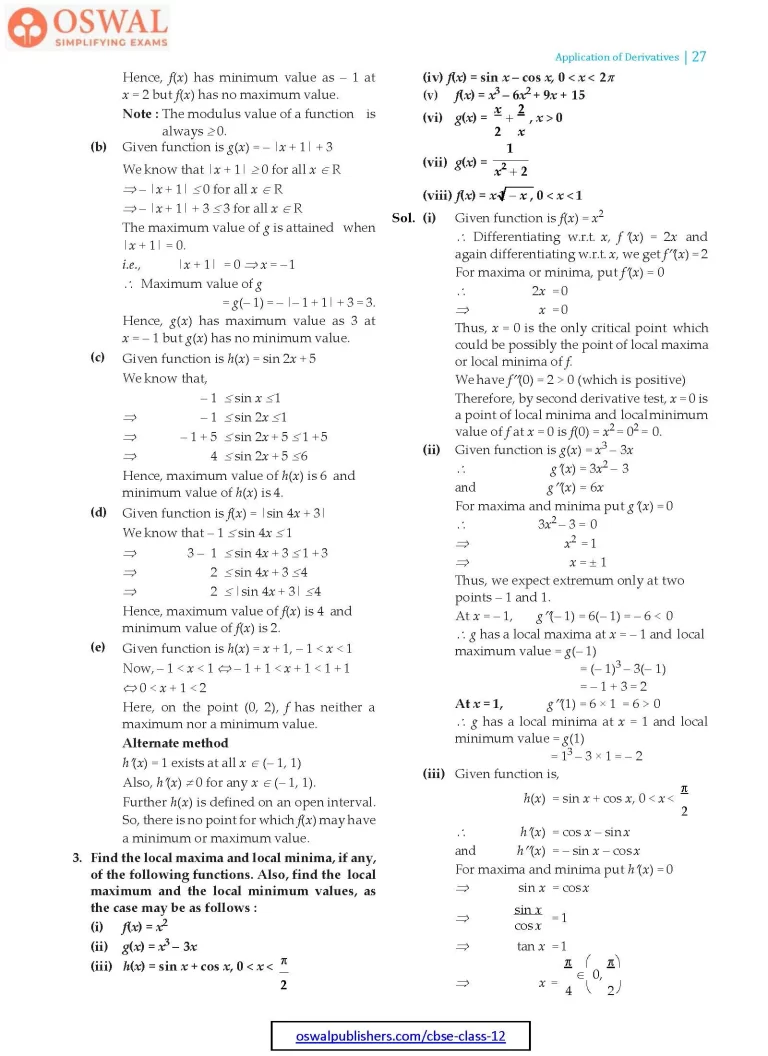
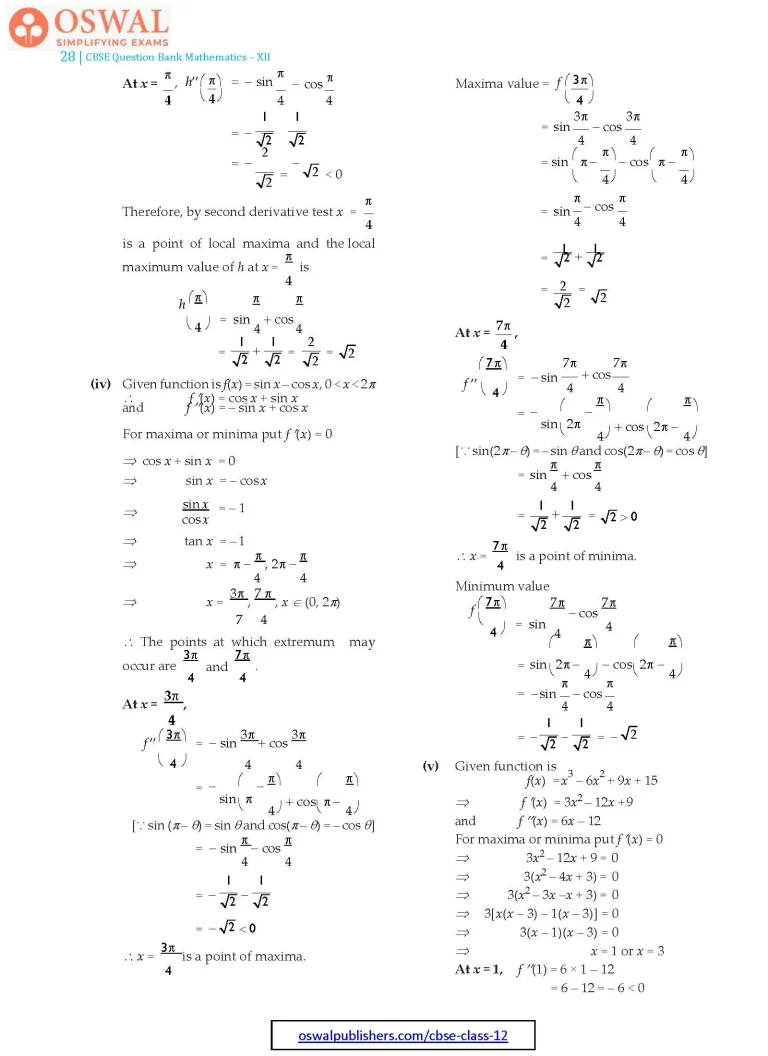
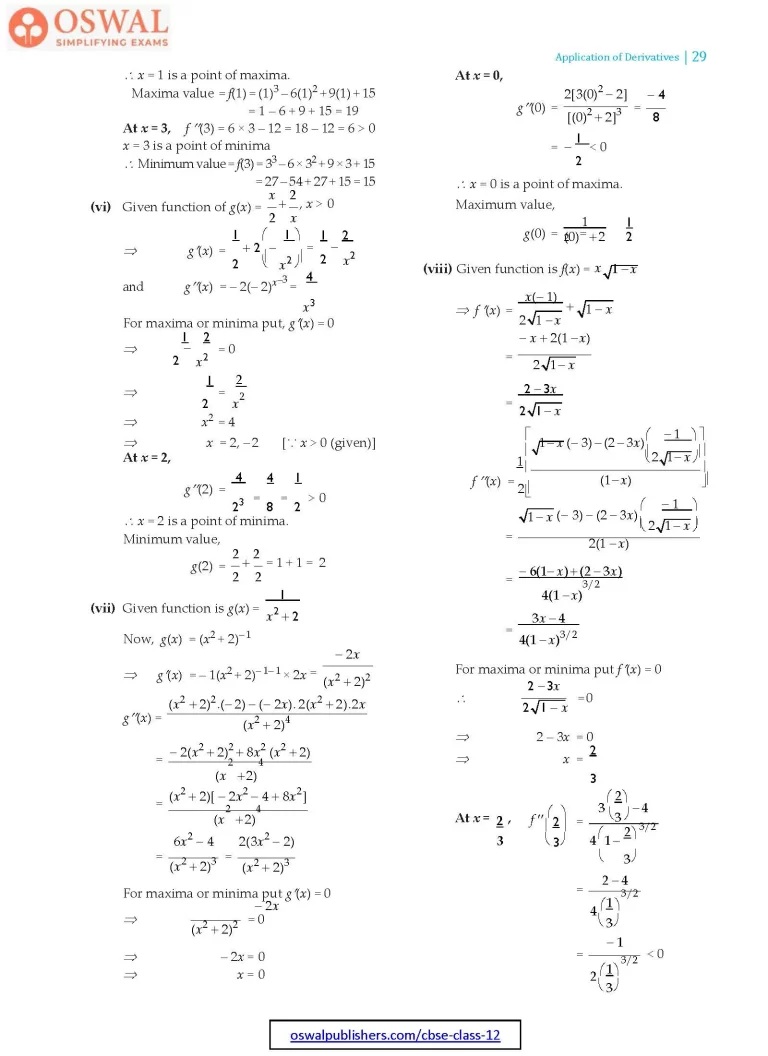
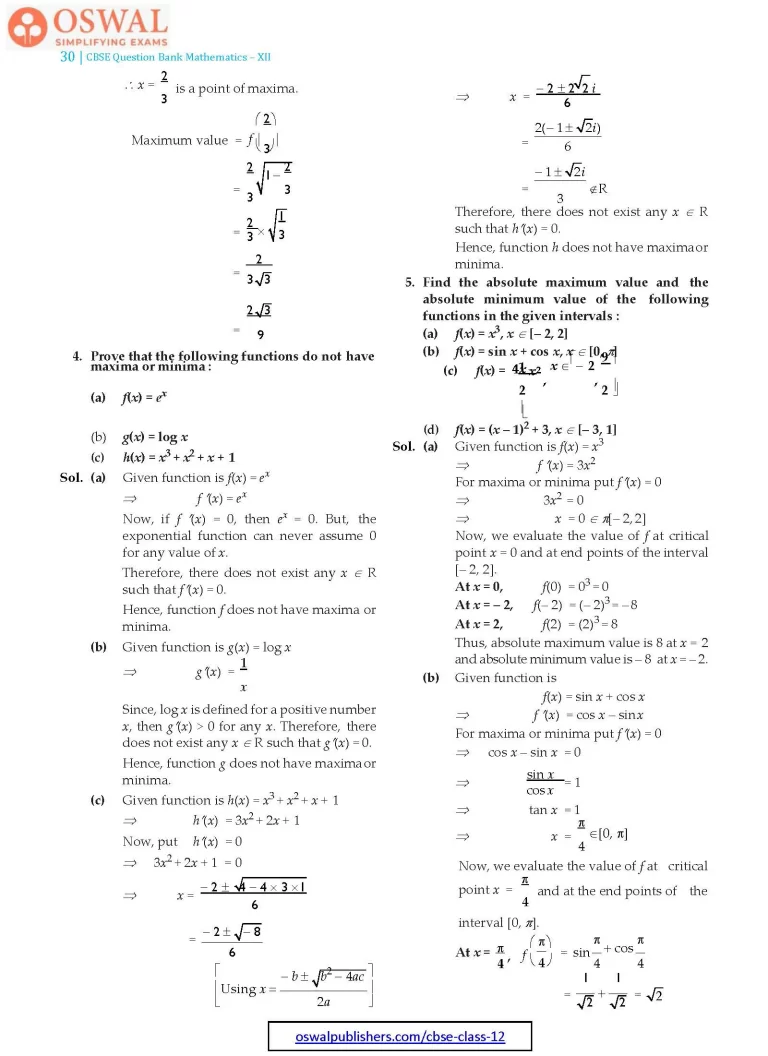
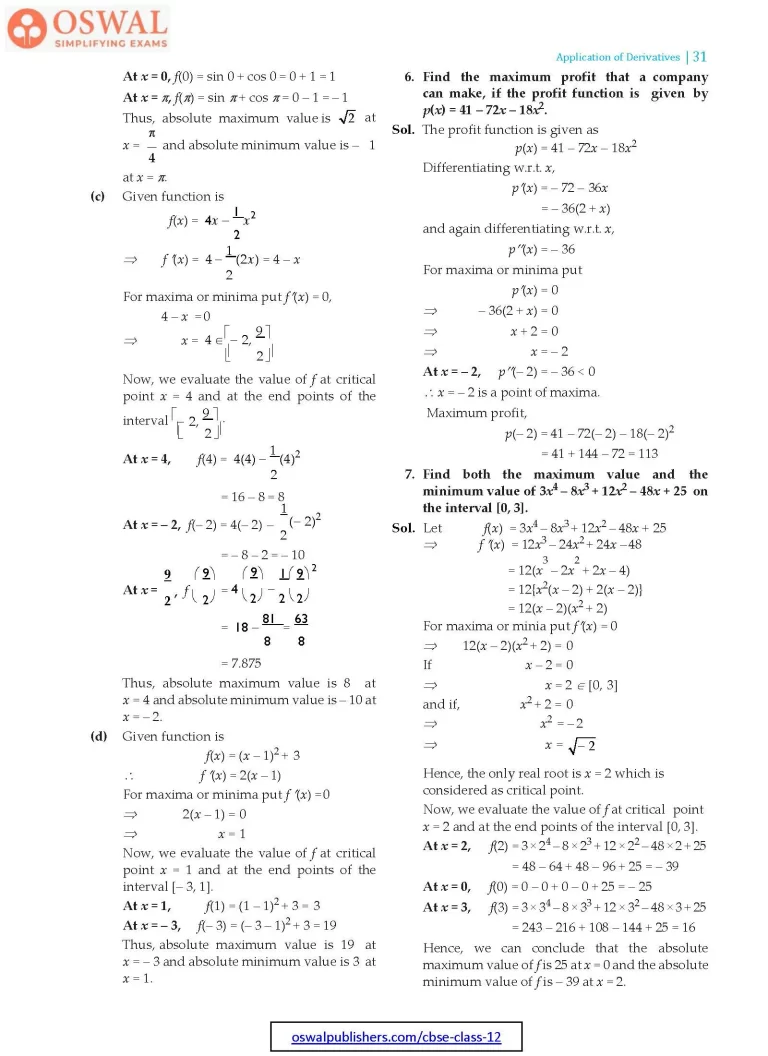
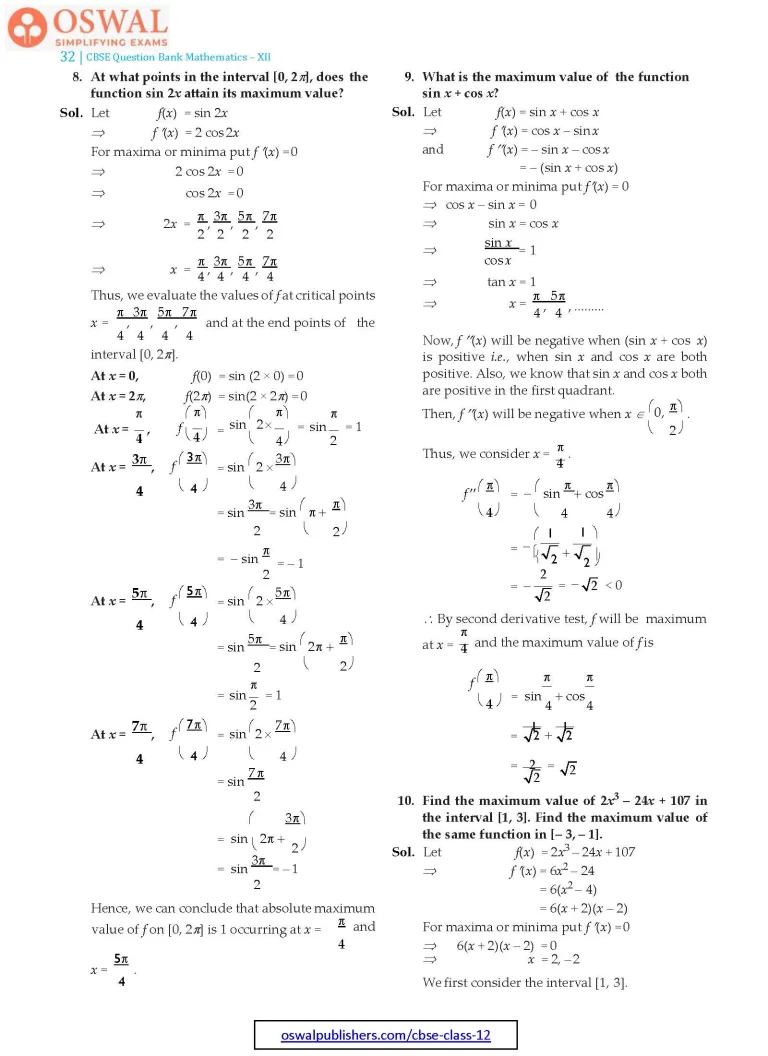
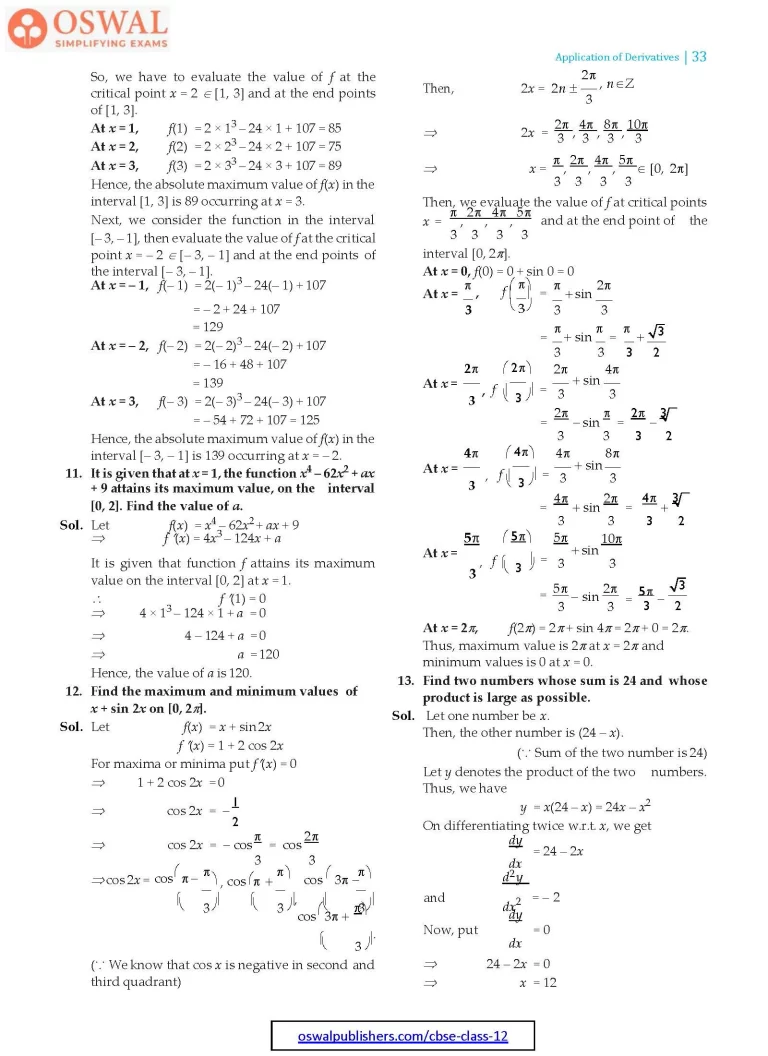
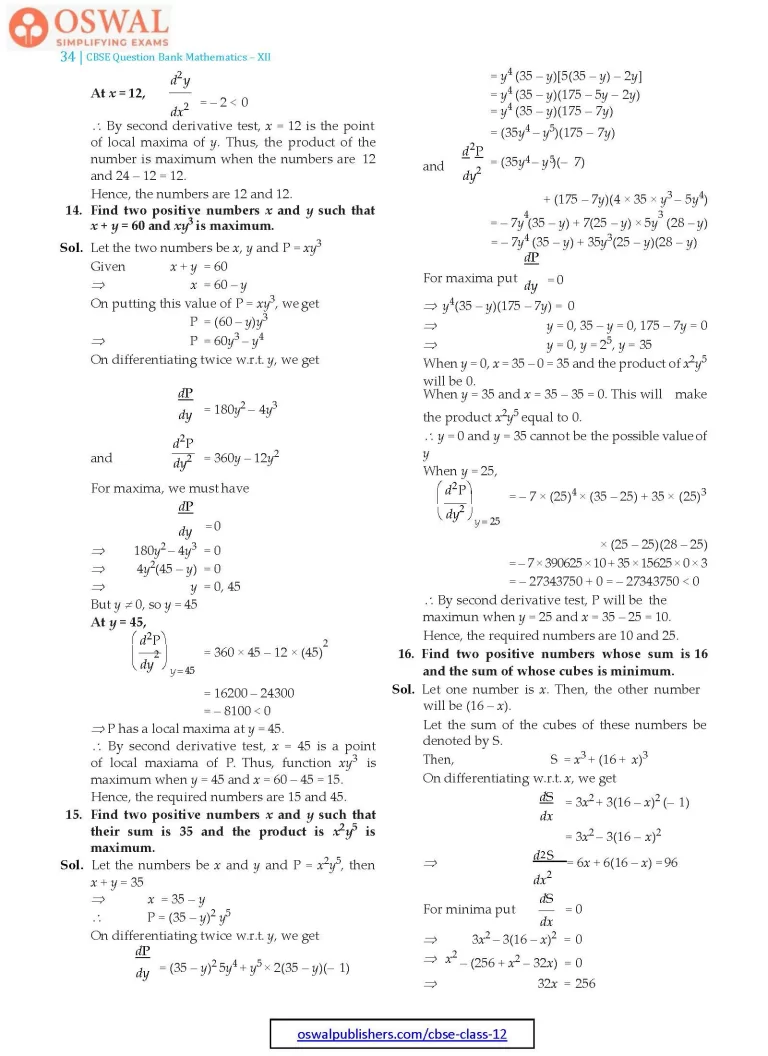
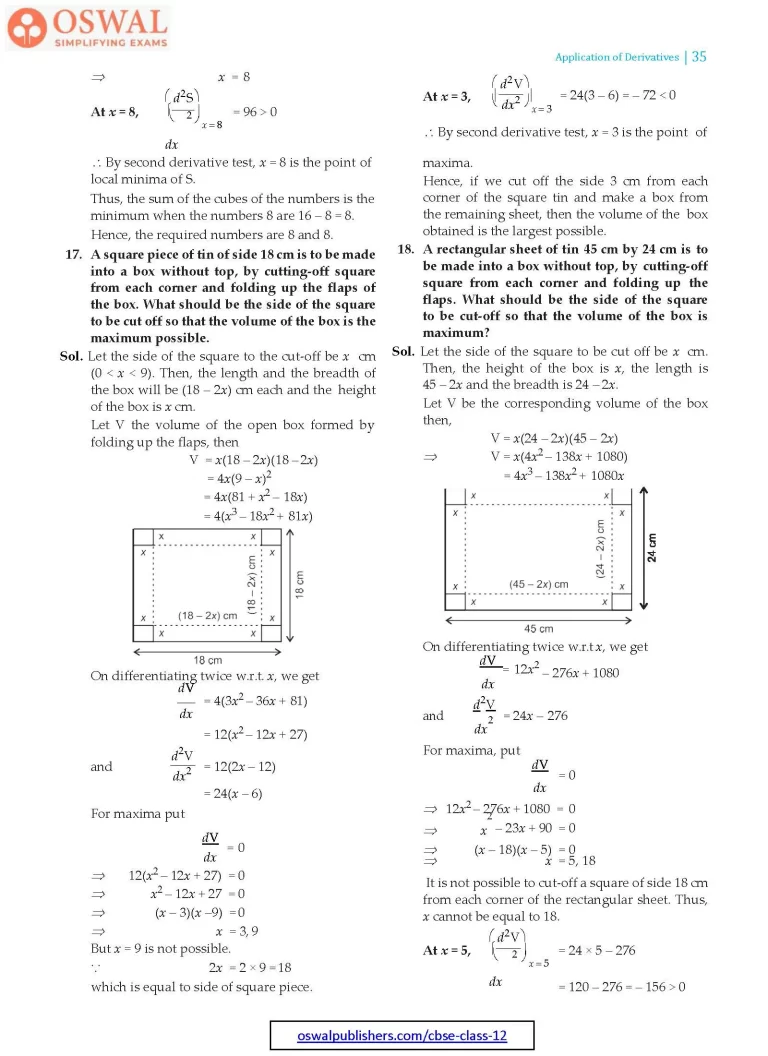
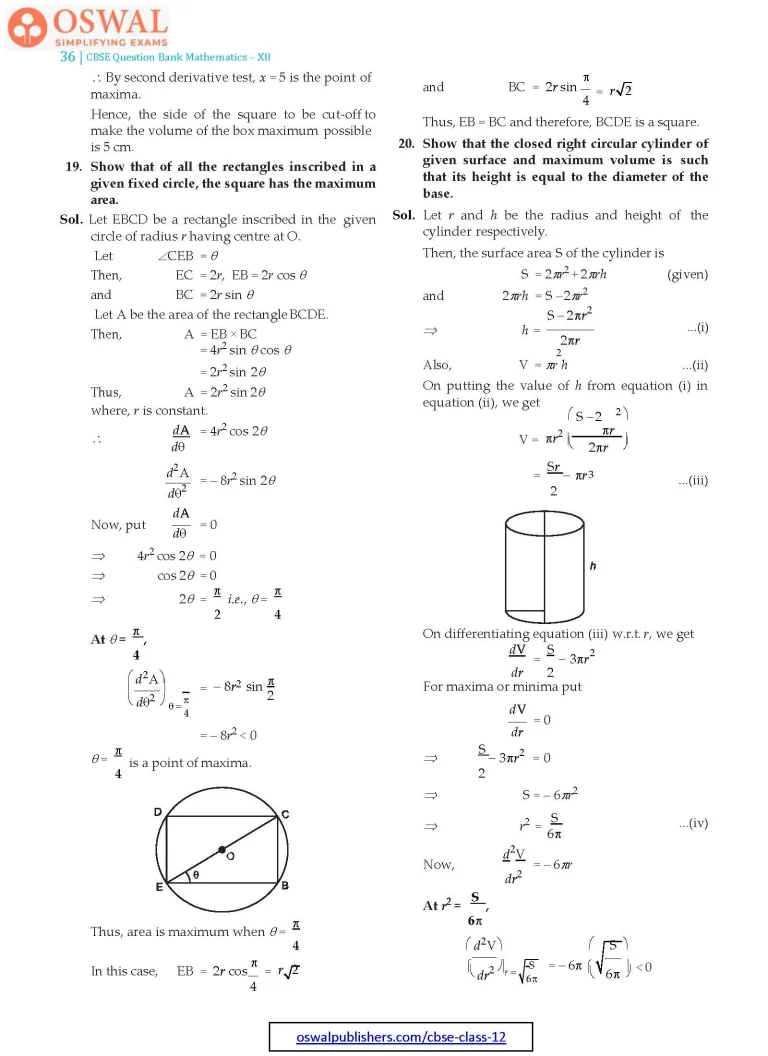
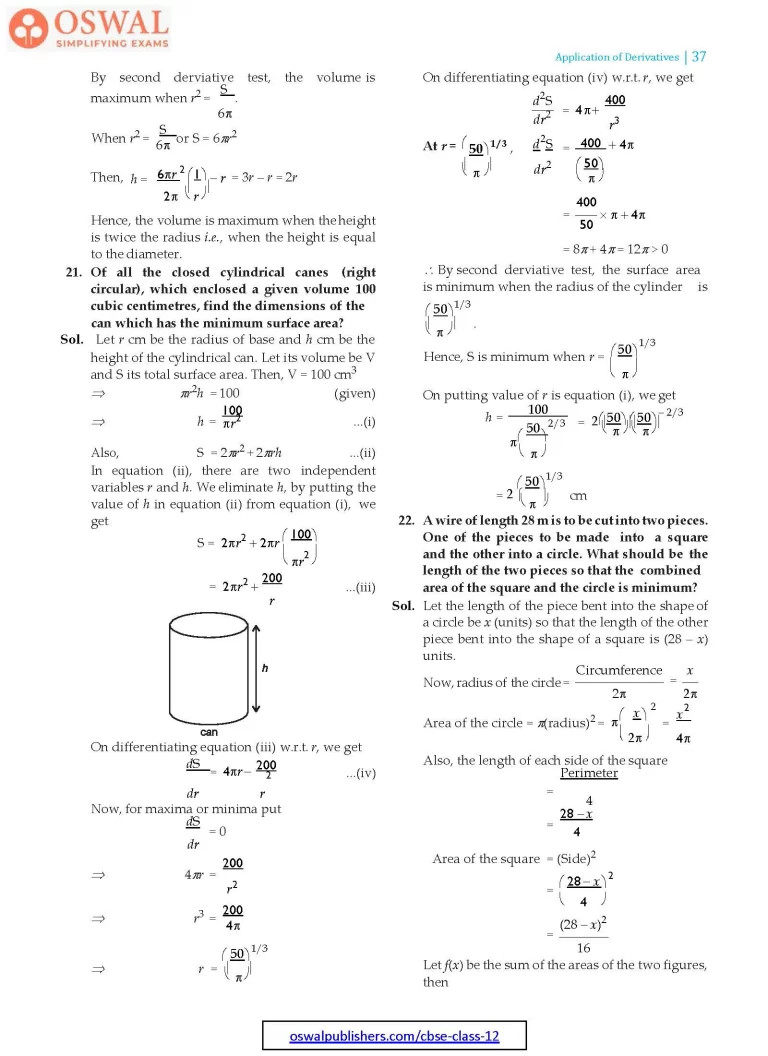
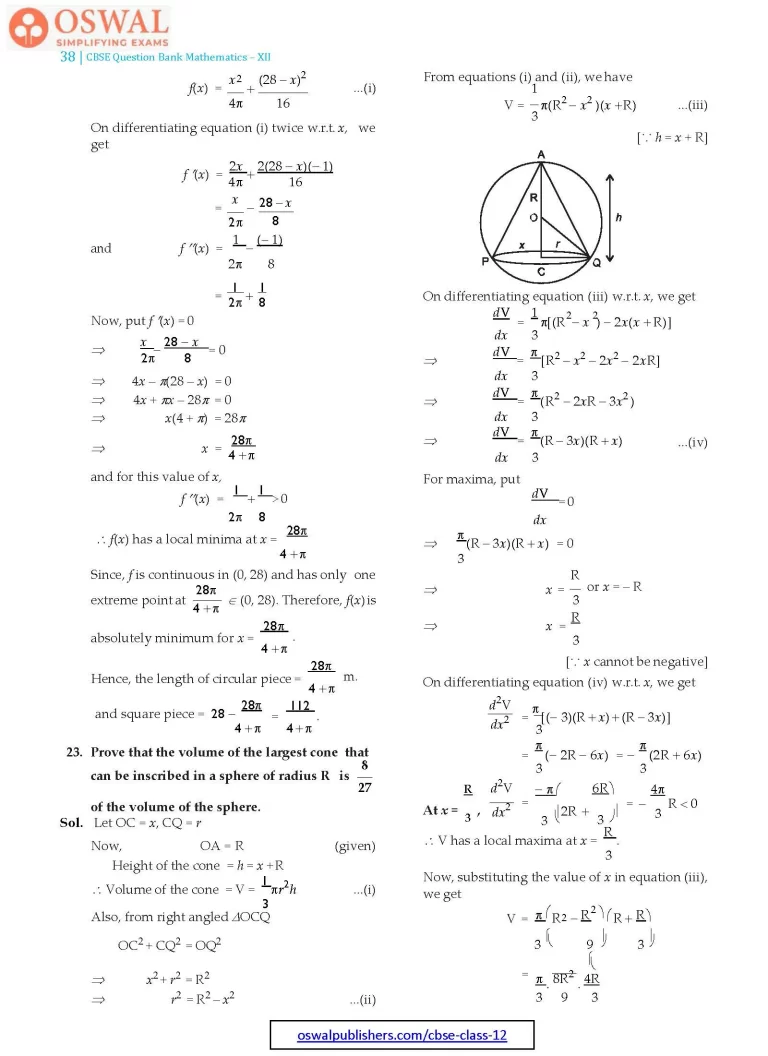
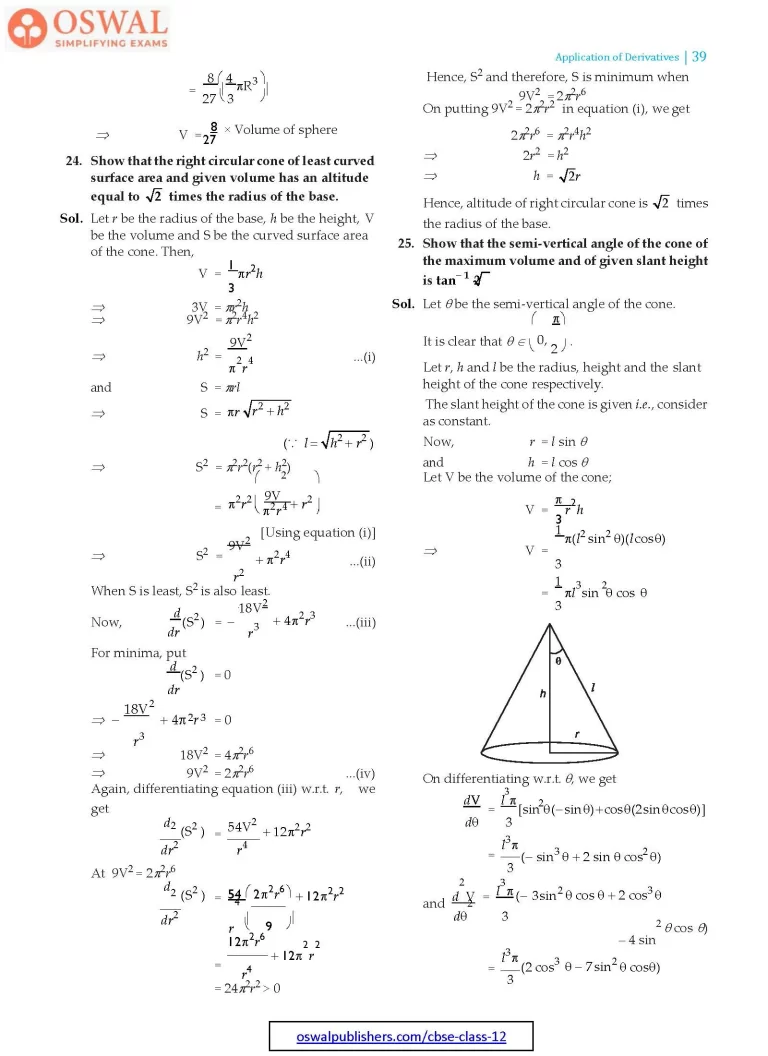
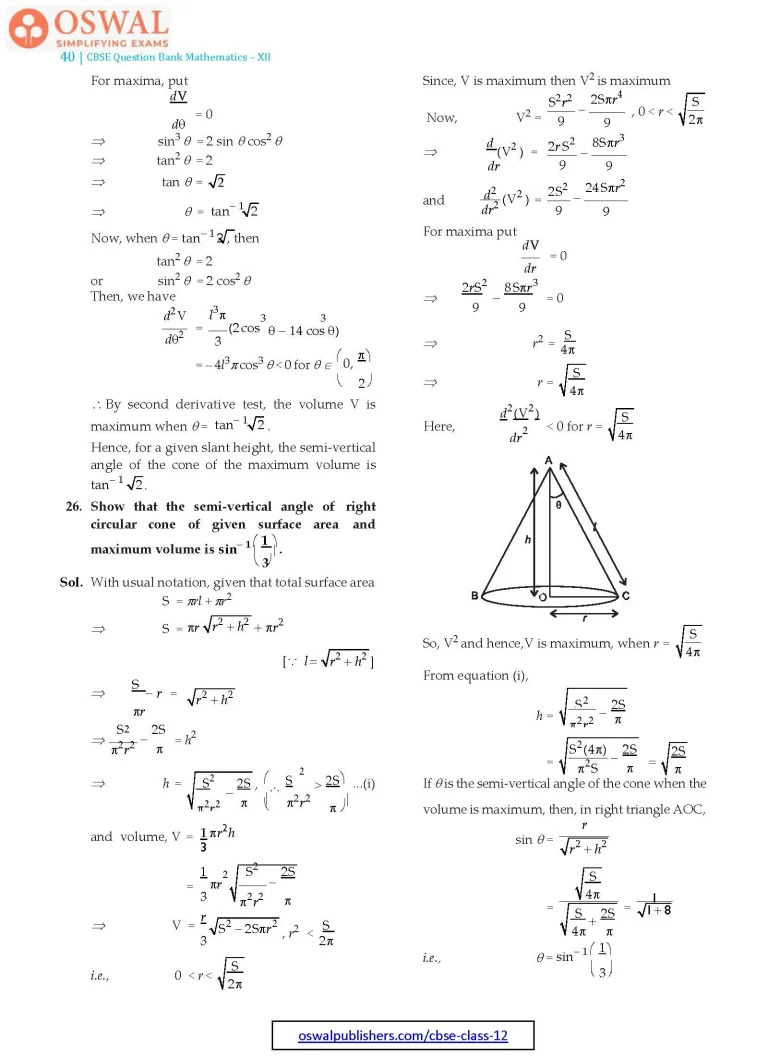
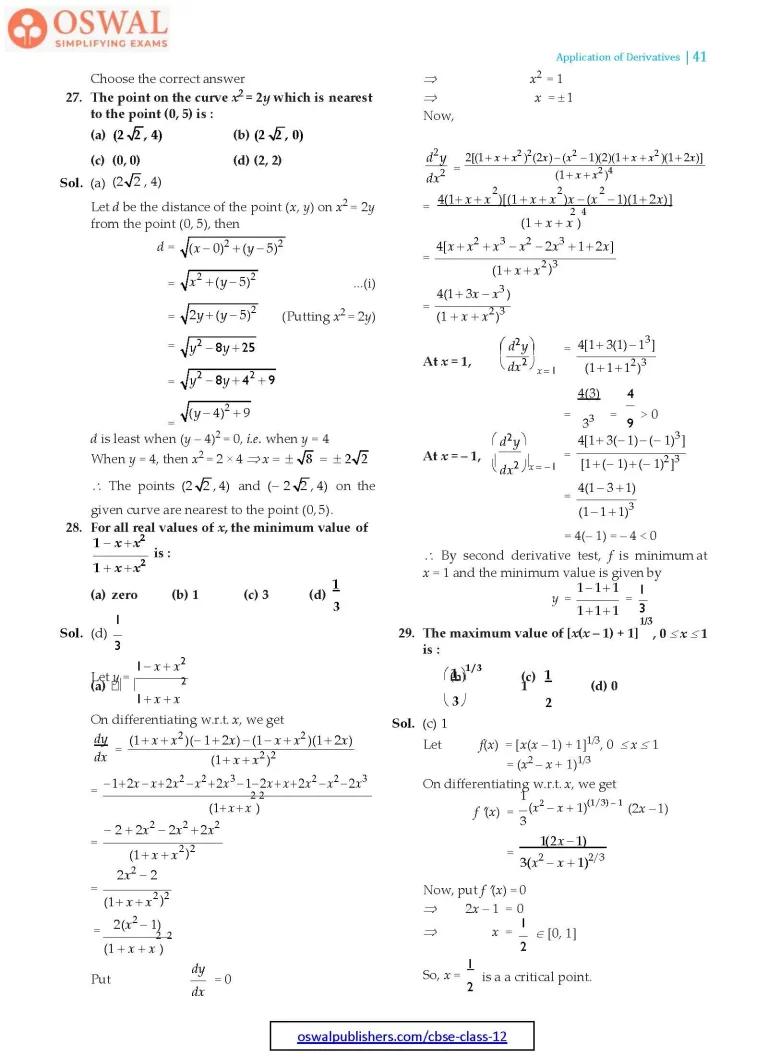
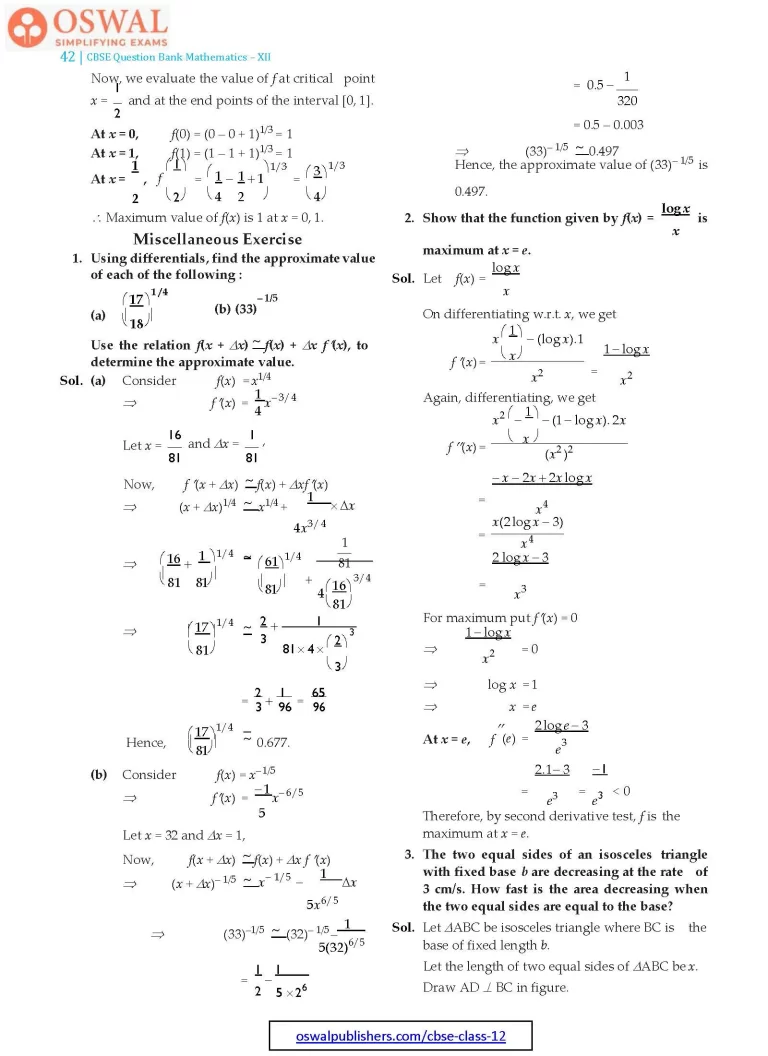
Access Exercises of Class 12 Maths Chapter 6 Application of Derivatives
Exercise 6.1 Solutions: 18 Questions (10 Long, 6 Short, 2 MCQs)
Exercise 6.2 Solutions: 19 Questions (10 Long, 7 Short, 2 MCQs)
Exercise 6.3 Solutions: 27 Questions (14 Long, 11 Short, 2 MCQs)
Exercise 6.4 Solutions: 9 Questions (7 Short, 2 MCQs)
Exercise 6.5 Solutions: 29 Questions (15 Long, 11 Short, 3 MCQs)
Miscellaneous Exercise Solutions: 24 Questions (14 Long, 4 Short, 6 MCQs)
Exercise 6.5
1. Find the maximum and minimum values, if any, of the following functions given by :
(a) f(x) = (2x – 1)2 + 3
(b) f(x) = 9x2 + 12x + 2
(c) f(x) = – (x – 1)2 + 10
(d) g(x) = x3 + 1.
Sol. (a) Given, function is f(x) = (2x – 1)2 + 3
It can be observed that (2x – 1)2 ≥ 0 for every x ∈ R
[Since, it is perfect square for any real number]
Therefore, f(x) = (2x – 1)2 + 3 ≥ 3 for every x ∈ R
The minimum value of f is attained when 2x – 1 = 0
i.e., 2x – 1 = 0
$$\Rarr\space x=\frac{1}{2}\\\therefore\space\text{Minimum value of f =}\space f\bigg(\frac{1}{2}\bigg)\\=\bigg(2×\frac{1}{2}-1\bigg)^2+3=3$$
For any value of x, value of f(x) will always be greater than 3, hence function f does not have particular maximum value.
(b) Given, function is
f(x) = 9x2 + 12x + 2
= 9x2 + 12x + 4 – 2
[We add and subtract 2 for making it perfect square]
= (9x2 + 6x + 6x + 4) – 2
= [3x(3x + 2) + 2(3x + 2)] – 2
= [(3x + 2)(3x + 2)] – 2
= (3x + 2)2 – 2
It can be observed that (3x + 2)2 ≥ 0 for every x ∈ R
Therefore, f(x) = (3x + 2)2 – 2 ≥ – 2 for every x ∈ R
The minimum value of f is attained when
3x + 2 = 0
i.e., 3x + 2 = 0
$$\Rarr\space x=\frac{-2}{3}\\\therefore\space\text{Minimum value of f = f}\space\bigg(\frac{-2}{3}\bigg)\\=\bigg(3×\frac{-2}{3}+2\bigg)^2=-2$$
For any value of x, f(x) ≥ – 2, hence function f does not have a particular maximum value.
(c) Given, function is f(x) = – (x – 1)2 + 10.
It can be observ ed that (x – 1)2 ≥ 0 for all
x ∈ R.
⇒ – (x – 1)2 ≤ 0 for every x ∈ R
Therefore, f(x) = – (x – 1)2 + 10 ≤ 10 for every x ∈ R
The maximum value of f is attained when
(x – 1) = 0
i.e., (x – 1) = 0 ⇒ x = 1
∴ Maximum value of f
= f(1) = – (1 – 1)2 + 10 = 10
For any value of x, f(x) ≤ 10, hence function f does not have a particular mimimum value.
(d) Given, function is g(x) = x3 + 1.
We observe that the value of f(x) increases when the value of x increase and f(x) can be made as large as we please by giving large value to x. So, f(x) does not have the maximum value. Similarly, f(x) can be made as small as we please by giving smaller values of x. So, f(x) does not have the minimum value.
Alternate method
Here, g(x) = x3 + 1
g′(x) = 3x2
g′′(x) = 6x
For maxima or minima put g′(x) = 0
⇒ 3x3 = 0
⇒ x = 0
At x = 0, g′′(0) = 6 × 0 = 0
Hence at x = 0, g(x) is neither maxima nor minima. It is a point of inflexion.
2. Find the maximum and minimum values, if any of the following functions given by :
(a) f(x) = |x + 2| – 1
(b) g(x) = – |x + 1| + 3
(c) h(x) = sin(2x) + 5
(d) f(x) = |sin 4x + 3|
(e) h(x) = x + 1, x ∈ (– 1, 1)
Sol. (a) Given, function is f(x) = |x + 2| – 1
We know that |x + 2| ≥ 0 for all x ∈ R.
Therefore, f(x) = |x + 2| – 1 ≥ – 1 for every x ∈ R.
The minimum value of f is attained when |x + 2| = 0.
i.e., |x + 2| = 0 ⇒ x = – 2
∴ Minimum value of f = f(– 2)
= |– 2 + 2| – 1 = 0 – 1 = – 1
Hence, f(x) has minimum value as – 1 at x = 2 but f(x) has no maximum value.
Note : The modulus value of a function is always ≥ 0.
(b) Given function is g(x) = – |x + 1| + 3
We know that |x + 1| ≥ 0 for all x ∈ R
⇒ – |x + 1| ≤ 0 for all x ∈ R
⇒ – |x + 1| + 3 ≤ 3 for all x ∈ R
The maximum value of g is attained when |x + 1| = 0.
i.e., |x + 1| = 0 ⇒ x = – 1
∴ Maximum value of g
= g(– 1) = – |– 1 + 1| + 3 = 3.
Hence, g(x) has maximum value as 3 at x = – 1 but g(x) has no minimum value.
(c) Given function is h(x) = sin 2x + 5
We know that,
– 1 ≤ sin x ≤ 1
⇒ – 1 ≤ sin 2x ≤ 1
⇒ – 1 + 5 ≤ sin 2x + 5 ≤ 1 + 5
⇒ 4 ≤ sin 2x + 5 ≤ 6
Hence, maximum value of h(x) is 6 and minimum value of h(x) is 4.
(d) Given function is f(x) = |sin 4x + 3|
We know that – 1 ≤ sin 4x ≤ 1
⇒ 3 – 1 ≤ sin 4x + 3 ≤ 1 + 3
⇒ 2 ≤ sin 4x + 3 ≤ 4
⇒ 2 ≤ |sin 4x + 3| ≤ 4
Hence, maximum value of f(x) is 4 and minimum value of f(x) is 2.
(e) Given function is h(x) = x + 1, – 1 < x < 1
Now , – 1 < x < 1 ⇔ – 1 + 1 < x + 1 < 1 + 1
⇔ 0 < x + 1 < 2
Here, on the point (0, 2), f has neither a maximum nor a minimum value.
Alternate method
h′(x) = 1 exists at all x ∈ (– 1, 1)
Also, h′(x) ≠ 0 for any x ∈ (– 1, 1).
Further h(x) is defined on an open interval.
So, there is no point for which f(x) may have a minimum or maximum value.
3. Find the local maxima and local minima, if any, of the following functions. Also, find the local maximum and the local minimum values, as the case may be as follows :
(i) f(x) = x2
(ii) g(x) = x3 – 3x
$$\textbf{(iii) h(x) = sin x + cos x, 0 < x}\lt\frac{\pi}{\textbf{2}}$$
(iv) f(x) = sin x – cos x, 0 < x < 2π
(v) f(x) = x3 – 6x2 + 9x + 15
$$\textbf{(vi)}\space \textbf{g(x)}\textbf{=}\frac{\textbf{x}}{\textbf{2}}+\frac{\textbf{2}}{\textbf{x}},\textbf{x}\gt \textbf{0}\\\textbf{(vii)\space g(x)}=\frac{\textbf{1}}{\textbf{x}^\textbf{2}\textbf{+2}} \\\textbf{(viii)\space f(x)}=\textbf{x}\sqrt{\textbf{1-x}}, \textbf{0}\lt \textbf{x}\lt \textbf{1}$$
Sol. (i) Given function is f(x) = x2
∴ Differentiating w.r.t. x, f ′(x) = 2x and again differentiating w.r.t. x, we get f ′′(x) = 2
For maxima or minima, put f ′(x) = 0
∴ 2x = 0
⇒ x = 0
Thus, x = 0 is the only critical point which could be possibly the point of local maxima or local minima of f.
We have f ′′(0) = 2 > 0 (which is positive)
Therefore, by second derivative test, x = 0 is a point of local minima and local minimum value of f at x = 0 is f(0) = x2 = 02 = 0.
(ii) Given function is g(x) = x3 – 3x
∴ g′(x) = 3x2 – 3
and g′′(x) = 6x
For maxima and minima put g′(x) = 0
∴ 3x2 – 3 = 0
⇒ x2 = 1
⇒ x = ± 1
Thus, we expect extremum only at two points – 1 and 1.
At x = – 1, g′′(– 1) = 6(– 1) = – 6 < 0
∴ g has a local maxima at x = – 1 and local maximum value = g(– 1)
= (– 1)3 – 3(– 1)
= – 1 + 3 = 2
At x = 1, g′′(1) = 6 × 1 = 6 > 0
∴ g has a local minima at x = 1 and local minimum value = g(1)
= 13 – 3 × 1 = – 2
(iii) Given function is,
$$\text{h(x) = sin x + cos x, 0}\lt x\lt \frac{\pi}{2}$$
∴ h′(x) = cos x – sin x
and h′′(x) = – sin x – cos x
For maxima and minima put h′(x) = 0
⇒ sin x = cos x
$$\Rarr\space \frac{\text{sin x}}{\text{cos x}}=1\\\Rarr\space \text{tan x}=1\\\Rarr\space x=\frac{\pi}{4}\epsilon\bigg(0,\frac{\pi}{2}\bigg)\\\text{At}\space x=\frac{\pi}{4},h''\bigg(\frac{\pi}{4}\bigg)\\=-\text{sin}\frac{\pi}{4}-\text{cos}\frac{\pi}{4}\\=-\frac{1}{\sqrt{2}}-\frac{1}{\sqrt{2}}\\=-\frac{2}{\sqrt{2}}=-\sqrt{2}\lt 0$$
Therefore, by second derivative test
$$x=\frac{\pi}{4}\space\text{is a point of local maxima and}\\\text{ the local maximum value of h at x}=\frac{\pi}{4}\space\text{is}\\h\bigg(\frac{\pi}{4}\bigg)=\text{sin}\frac{\pi}{4}+\text{cos}\frac{\pi}{4}\\=\frac{1}{\sqrt{2}}+\frac{1}{\sqrt{2}}=\frac{2}{\sqrt{2}}=\sqrt{2}$$
(iv) Given function is f(x) = sin x – cos x, 0 < x < 2π
∴ f ′(x) = cos x + sin x
and f ′′(x) = – sin x + cos x
For maxima or minima put f ′(x) = 0
⇒ cos x + sin x = 0
⇒ sin x = – cos x
$$\Rarr\space\frac{\text{sin x}}{\text{cos x}}=-1$$
⇒ tan x = – 1
$$\Rarr\space x=\pi-\frac{\pi}{4},2\pi-\frac{\pi}{4}\\\Rarr\space x=\frac{3\pi}{7},\frac{7\pi}{4},\space x\epsilon(0,2\pi)$$
∴ The points at which extremum may occur are
$$\frac{3\pi}{4}\space\text{and}\frac{7\pi}{4}.\\\text{At x=}\frac{3\pi}{4},\\f''\bigg(\frac{3\pi}{4}\bigg)=-\text{sin}\frac{3\pi}{4}+\text{cos}\frac{3\pi}{4}\\=-\text{sin}\bigg(\pi-\frac{\pi}{4}\bigg) + \text{cos}\bigg(\pi-\frac{\pi}{4}\bigg)$$
[∵ sin (π – θ) = sin θ and cos(π – θ) = – cos θ]
$$=-\text{sin}\frac{\pi}{4}-\text{cos}\frac{\pi}{4}\\=-\frac{1}{\sqrt{2}}-\frac{1}{\sqrt{2}}\\=-\sqrt{2}\lt0\\\therefore\space x=\frac{3\pi}{4}\space\text{is a point of maxima.}$$
$$\text{Maxima value = }f\bigg(\frac{3\pi}{4}\bigg)\\=\text{sin}\frac{3\pi}{4}-\text{cos}\space\frac{3\pi}{4}\\=\text{sin}\bigg(\pi-\frac{\pi}{4}\bigg)-\text{cos}\bigg(\pi-\frac{\pi}{4}\bigg)\\=\text{sin}\frac{\pi}{4}-\text{cos}\frac{\pi}{4}\\=\frac{1}{\sqrt{2}}+\frac{1}{\sqrt{2}}\\=\frac{2}{\sqrt{2}}=\sqrt{2}\\\text{At x=}\frac{7\pi}{4},$$
$$f''\bigg(\frac{7\pi}{4}\bigg)=-\text{sin}\frac{7\pi}{4}+\text{cos}\frac{7\pi}{4}\\=-\text{sin}\bigg(2\pi-\frac{\pi}{4}\bigg) + \text{cos}\bigg(2\pi-\frac{\pi}{4}\bigg)$$
[∵ sin(2π – θ) = – sin θ and cos(2π – θ) = cos θ]
$$=\text{sin}\frac{\pi}{4}+\text{cos}\frac{\pi}{4}\\=\frac{1}{\sqrt{2}}+\frac{1}{\sqrt{2}}=\sqrt{2}\gt 0\\\therefore\space x=\frac{7\pi}{4}\space\text{is a point of minima.}\\\text{Minimum value}\\ f\bigg(\frac{7\pi}{4}\bigg)=\text{sin}\frac{7\pi}{4}-\text{cos}\frac{7\pi}{4}\\=\text{sin}\bigg(2\pi-\frac{\pi}{4}\bigg)-\text{cos}\bigg(2\pi-\frac{\pi}{4}\bigg)\\=-\text{sin}\frac{\pi}{4}-\text{cos}\frac{\pi}{4}\\=-\frac{1}{\sqrt{2}}-\frac{1}{\sqrt{2}}=-\sqrt{2}$$
(v) Given function is
f(x) = x3 – 6x2 + 9x + 15
⇒ f ′(x) = 3x2 – 12x + 9
and f ′′(x) = 6x – 12
For maxima or minima put f ′(x) = 0
⇒ 3x2 – 12x + 9 = 0
⇒ 3(x2 – 4x + 3) = 0
⇒ 3(x2 – 3x –x + 3) = 0
⇒ 3[x(x – 3) – 1(x – 3)] = 0
⇒ 3(x – 1)(x – 3) = 0
⇒ x = 1 or x = 3
At x = 1, f ′′(1) = 6 × 1 – 12
= 6 – 12 = – 6 < 0
∴ x = 1 is a point of maxima.
Maxima value = f(1) = (1)3 – 6(1)2 + 9(1) + 15
= 1 – 6 + 9 + 15 = 19
At x = 3, f ′′(3) = 6 × 3 – 12 = 18 – 12 = 6 > 0
x = 3 is a point of minima
∴ Minimum value = f(3) = 33 – 6 × 32 + 9 × 3 + 15
= 27 – 54 + 27 + 15 = 15
$$\textbf{(vi)}\space\text{Given function of}\\ \text{g(x) =}\frac{x}{2}+\frac{2}{x},x\gt0\\\Rarr\space g'(x)=\frac{1}{2}+2\bigg(-\frac{1}{x^2}\bigg)\\=\frac{1}{2}-\frac{2}{x^2}\\\text{and}\space g''(x)=-2(-2)^{x^{\normalsize -3}}=\frac{4}{x^3}$$
For maxima or minima put, g′(x) = 0
$$\Rarr\space \frac{1}{2}-\frac{2}{x^2}=0\\\Rarr\space \frac{1}{2}=\frac{2}{x^2}$$
⇒ x2 = 4
⇒ x = 2, – 2 [∵ x > 0 (given)]
At x = 2,
$$g''(2)=\frac{4}{2^3}=\frac{4}{8}=\frac{1}{2}\gt 0$$
∴ x = 2 is a point of minima.
Minimum value,
$$\text{g(2)}=\frac{2}{2}+\frac{2}{2}=1+1=2\\\textbf{(vii)}\space\text{Given function is g(x) =}\frac{1}{x^2+2}$$
Now, g(x) = (x2 + 2)– 1
$$⇒ g′(x) = – 1(x^2 + 2)^{\normalsize– 1– 1} × 2x=\frac{-2x}{(x^2+2)^2}$$
$$g''(x)=\frac{(x^2+2)^2.(-2)-(-2x).2(x^2+2).2x}{(x^2+2)^4}\\=\frac{-2(x^2+2)^2+8x^2(x^2+2)}{(x^2+2)^4}\\=\frac{(x^2+2)[-2x^2-4+8x^2]}{(x^2+2)^4}\\=\frac{6x^2-4}{(x^2+2)^3}=\frac{2(3x^2-2)}{(x^2+2)^3}$$
For maxima or minima put g′(x) = 0
$$\Rarr\space\frac{-2x}{(x^2+2)^2}=0$$
⇒ – 2x = 0
⇒ x = 0
At x = 0,
$$g''(0)=\frac{2[3(0)^2-2]}{[(0)^2+2]^3}=\frac{-4}{8}\\=-\frac{1}{2}\lt 0$$
∴ x = 0 is a point of maxima.
Maximum value,
$$\text{g(0)}=\frac{1}{(0)^2+2}=\frac{1}{2}\\\textbf{(viii)\space}\text{Given function is f(x) =} x\sqrt{1-x}\\\Rarr\space f'(x)=\frac{x(-1)}{2\sqrt{1-x}}+\sqrt{1-x}\\=\frac{-x+2(1-x)}{2\sqrt{1-x}}\\=\frac{2-3x}{2\sqrt{1-x}}\\f'(x)=\frac{1}{2}\bigg[\frac{\sqrt{1-x}(-3)-(2-3x)\bigg(\frac{1}{2\sqrt{1-x}}\bigg)}{(1-x)}\bigg]$$
$$=\frac{\sqrt{1-x}(-3)-(2-3x)\bigg(\frac{-1}{2\sqrt{1-x}}\bigg)}{2(1-x)}\\=\frac{-6(1-x) + (2-3x)}{4(1-x)^{3/2}}\\=\frac{3x-4}{4(1-x)^{3/2}}\\\text{For maxima or minima put f ′(x) = 0}\\\therefore\space \frac{2-3x}{2\sqrt{1-x}}=0$$
⇒ 2 – 3x = 0
$$\Rarr\space x=\frac{2}{3}\\\text{At x=}\frac{2}{3},\space f''\bigg(\frac{2}{3}\bigg)=\frac{3\bigg(\frac{2}{3}\bigg)-4}{4\bigg(1-\frac{2}{3}\bigg)^{3/2}}\\=\frac{2-4}{4\bigg(\frac{1}{3}\bigg)^{3/2}}\\=\frac{-1}{2\bigg(\frac{1}{3}\bigg)^{3/2}}\lt0$$
$$\therefore\space x=\frac{2}{3}\space\text{is a point of maxima.}\\\text{Maximum value = f}\bigg(\frac{2}{3}\bigg)\\=\frac{2}{3}\sqrt{1-\frac{2}{3}}\\=\frac{2}{3} ×\sqrt{\frac{1}{3}}\\=\frac{2}{3\sqrt{3}}\\=\frac{2\sqrt{3}}{9}$$
4. Prove that the following functions do not have maxima or minima :
(a) f(x) = ex
(b) g(x) = log x
(c) h(x) = x3 + x2 + x + 1
Sol. (a) Given function is f(x) = ex
⇒ f ′(x) = ex
Now , if f ′(x) = 0, then ex = 0. But, the exponential function can never assume 0 for any value of x.
Therefore, there does not exist any x ∈ R such that f ′(x) = 0.
Hence, function f does not have maxima or minima.
(b) Given function is g(x) = log x
$$\Rarr\space g'(x)=\frac{1}{x}$$
Since, log x is defined for a positive number x, then g′(x) > 0 for any x. Therefore, there does not exist any x ∈ R such that g′(x) = 0.
Hence, function g does not have maxima or minima.
(c) Given function is h(x) = x3 + x2 + x + 1
⇒ h′(x) = 3x2 + 2x + 1
Now, put h′(x) = 0
⇒ 3x2 + 2x + 1 = 0
$$\Rarr\space x=\frac{-2\pm\sqrt{4-4 × 3 ×1}}{6}\\=\frac{-2\pm\sqrt{-8}}{6}\\\bigg[\text{Using x}=\frac{-b\pm\sqrt{b^2-4ac}}{2a}\bigg]\\\Rarr\space x=\frac{-2\pm2\sqrt{2}i}{6}\\=\frac{2(-1\pm\sqrt{2}i)}{6}\\=\frac{-1\pm\sqrt{2}i}{3}\notin\text{R}$$
Therefore, there does not exist any x ∈ R such that h′(x) = 0.
Hence, function h does not have maxima or minima.
5. Find the absolute maximum value and the absolute minimum value of the following functions in the given intervals :
(a) f(x) = x3, x ∈ [– 2, 2]
(b) f(x) = sin x + cos x, x ∈ [0, π]
$$\textbf{(c) f(x) = 4 x}-\frac{\textbf{1}}{\textbf{2}}\textbf{x}^\textbf{2}, \textbf{x}\notin\bigg[\textbf{-2,}\frac{\textbf{9}}{\textbf{2}}\bigg]$$
(d) f(x) = (x – 1)2 + 3, x ∈ [– 3, 1]
Sol. (a) Given function is f(x) = x3
⇒ f ′(x) = 3x2
For maxima or minima put f ′(x) = 0
⇒ 3x2 = 0
⇒ x = 0 ∈ π[– 2, 2]
Now , we evaluate the value of f at critical point x = 0 and at end points of the interval [– 2, 2].
At x = 0, f(0) = 03 = 0
At x = – 2, f(– 2) = (– 2)3 = – 8
At x = 2, f(2) = (2)3 = 8
Thus, absolute maximum value is 8 at x = 2 and absolute minimum value is – 8 at x = – 2.
(b) Given function is
f(x) = sin x + cos x
⇒ f ′(x) = cos x – sin x
For maxima or minima put f ′(x) = 0
⇒ cos x – sin x = 0
$$\Rarr\space\frac{\text{sin x}}{\text{cos x}}=1$$
⇒ tan x = 1
$$\Rarr\space x=\frac{\pi}{4}\epsilon[0,\pi]$$
Now, we evaluate the value of f at critical point
$$x=\frac{\pi}{4}\space\text{and at the end points of the interval [0, }\pi].\\\text{At x=}\frac{\pi}{4}\space, f\bigg(\frac{\pi}{4}\bigg)=\text{sin}\frac{\pi}{4}+\text{cos}\frac{\pi}{4}\\=\frac{1}{\sqrt{2}}+\frac{1}{\sqrt{2}}=\sqrt{2}$$
At x = 0, f(0) = sin 0 + cos 0 = 0 + 1 = 1
At x = π, f(π) = sin p + cos p = 0 – 1 = – 1
Thus, absolute maximum value is
$$\sqrt{2}\space\text{at}\space x=\frac{\pi}{4}\space\text{and absolute minimum value} \\\text{is – 1 at x = π.}$$
(c) Given function is
$$f(x)=4x-\frac{1}{2}x^2\\\Rarr\space f'(x)=4-\frac{1}{2}(2x)=4-x$$
For maxima or minima put f ′(x) = 0,
4 – x = 0
$$\Rarr\space x=4\epsilon\bigg[-2,\frac{9}{2}\bigg]$$
Now , we evaluate the value of f at critical point x = 4 and at the end points of the interval
$$\bigg[-2,\frac{9}{2}\bigg].\\\text{At x = 4,}\space\text{f(4)=4(4)-}\frac{1}{2}(4)^2$$
= 16 – 8 = 8
$$\text{At x=-2},f(-2)=4(-2)-\frac{1}{2}(-2)^2\\=-8-2=-10\\\text{At x=}\frac{9}{2},\space f\bigg(\frac{9}{2}\bigg)\\=4\bigg(\frac{9}{2}\bigg)-\frac{1}{2}\bigg(\frac{9}{2}\bigg)^2\\=18-\frac{81}{8}=\frac{63}{8}$$
= 7.875
Thus, absolute maximum value is 8 at x = 4 and absolute minimum value is – 10 at x = – 2.
(d) Given function is
f(x) = (x – 1)2 + 3
∴ f ′(x) = 2(x – 1)
For maxima or minima put f ′(x) = 0
⇒ 2(x – 1) = 0
⇒ x = 1
Now , we evaluate the value of f at critical point x = 1 and at the end points of the interval [– 3, 1].
At x = 1, f(1) = (1 – 1)2 + 3 = 3
At x = – 3, f(– 3) = (– 3 – 1)2 + 3 = 19
Thus, absolute maximum value is 19 at x = – 3 and absolute minimum value is 3 at x = 1.
6. Find the maximum profit that a company can make, if the profit function is given by
p(x) = 41 – 72x – 18x2.
Sol. The profit function is given as
p(x) = 41 – 72x – 18x2
Differentiating w.r.t. x,
p′(x) = – 72 – 36x
= – 36(2 + x)
and again differentiating w.r.t. x,
p′′(x) = – 36
For maxima or minima put
p′(x) = 0
⇒ – 36(2 + x) = 0
⇒ x + 2 = 0
⇒ x = – 2
At x = – 2, p′′(– 2) = – 36 < 0
∴ x = – 2 is a point of maxima.
Maximum profit,
p(– 2) = 41 – 72(– 2) – 18(– 2)2
= 41 + 144 – 72 = 113
7. Find both the maximum value and the minimum value of 3x4 – 8x3 + 12x2 – 48x + 25 on the interval [0, 3].
Sol. Let f(x) = 3x4 – 8x3 + 12x2 – 48x + 25
⇒ f ′(x) = 12x3 – 24x2 + 24x – 48
= 12(x3 – 2x2 + 2x – 4)
= 12{x2(x – 2) + 2(x – 2)}
= 12(x – 2)(x2 + 2)
For maxima or minia put f ′(x) = 0
⇒ 12(x – 2)(x2 + 2) = 0
If x – 2 = 0
⇒ x = 2 ∈ [0, 3]
and if, x2 + 2 = 0
⇒ x2 = – 2
$$\Rarr\space x=\sqrt{-2}$$
Hence, the only real root is x = 2 which is considered as critical point.
Now , we evaluate the value of f at critical point x = 2 and at the end points of the interval [0, 3].
At x = 2, f(2) = 3 × 24 – 8 × 23 + 12 × 22 – 48 × 2 + 25
= 48 – 64 + 48 – 96 + 25 = – 39
At x = 0, f(0) = 0 – 0 + 0 – 0 + 25 = – 25
At x = 3, f(3) = 3 × 34 – 8 × 33 + 12 × 32 – 48 × 3 + 25
= 243 – 216 + 108 – 144 + 25 = 16
Hence, we can conclude that the absolute maximum value of f is 25 at x = 0 and the absolute minimum value of f is – 39 at x = 2.
8. At what points in the interval [0, 2π], does the function sin 2x attain its maximum value?
Sol. Let f(x) = sin 2x
⇒ f ′(x) = 2 cos 2x
For maxima or minima put f ′(x) = 0
⇒ 2 cos 2x = 0
⇒ cos 2x = 0
$$\Rarr\space 2x=\frac{\pi}{2},\frac{3\pi}{2},\frac{5\pi}{2},\frac{7\pi}{2}\\\Rarr\space x=\frac{\pi}{4},\frac{3\pi}{4},\frac{5\pi}{4},\frac{7\pi}{4}$$
Thus, we evaluate the values of f at critical points
$$x=\frac{\pi}{4},\frac{3\pi}{4},\frac{5\pi}{4},\frac{7\pi}{4}\space\\\text{and at the end points of the interval [0, 2}\pi].$$
At x = 0, f(0) = sin (2 × 0) = 0
At x = 2π, f(2π) = sin(2 × 2π) = 0
$$\text{At x=}\frac{\pi}{4},\space f\bigg(\frac{\pi}{4}\bigg)=\text{sin}\bigg(2×\frac{\pi}{4}\bigg)\\=\text{sin}\frac{\pi}{2}=1\\\text{At x}=\frac{3\pi}{4},\space f\bigg(\frac{3\pi}{4}\bigg)=\text{sin}\bigg(2×\frac{3\pi}{4}\bigg)\\=\text{sin}\space\frac{3\pi}{2}=\text{sin}\bigg(\pi+\frac{\pi}{2}\bigg)\\=-\text{sin}\frac{\pi}{2}=-1$$
$$\text{At x =}\frac{5\pi}{4},\space f\bigg(\frac{5\pi}{4}\bigg)=\text{sin}\bigg(2×\frac{5\pi}{4}\bigg)\\=\text{sin}\frac{5\pi}{2}=\text{sin}\bigg(2\pi+\frac{\pi}{2}\bigg)\\=\text{sin}\frac{\pi}{2}=1$$
$$\text{At x =}\frac{7\pi}{4},\space f\bigg(\frac{7\pi}{4}\bigg)=\text{sin}\bigg(2×\frac{7\pi}{4}\bigg)\\=\text{sin}\frac{7\pi}{2}\\=\text{sin}\bigg(2\pi + \frac{3\pi}{2}\bigg)\\=\text{sin}\frac{3\pi}{2}=-1$$
Hence, we can conclude that absolute maximum value of f on [0, 2p] is 1 occurring at
$$x=\frac{\pi}{4}\space\text{and}\space x=\frac{5\pi}{4}.$$
9. What is the maximum value of the function sin x + cos x?
Sol. Let f(x) = sin x + cos x
⇒ f ′(x) = cos x – sin x
and f ′′(x) = – sin x – cos x
= – (sin x + cos x)
For maxima or minima put f ′(x) = 0
⇒ cos x – sin x = 0
⇒ sin x = cos x
$$\Rarr\space \frac{\text{sin x}}{\text{cos x}}=1$$
⇒ tan x = 1
$$\Rarr\space x=\frac{\pi}{4},\frac{5\pi}{4},........$$
Now , f ′′(x) will be negative when (sin x + cos x) is positive i.e., when sin x and cos x are both positive. Also, we know that sin x and cos x both are positive in the first quadrant.
Then, f ′′(x) will be negative
$$\text{when}\space x\epsilon\bigg(0,\frac{\pi}{2}\bigg).\\\text{Thus, we consider}\space x=\frac{\pi}{4}.\\f''\bigg(\frac{\pi}{4}\bigg)=-\bigg(\text{sin}\frac{\pi}{4} + \text{cos}\frac{\pi}{4}\bigg)\\=-\bigg(\frac{1}{\sqrt{2}}+\frac{1}{\sqrt{2}}\bigg)\\=-\frac{2}{\sqrt{2}}=-\sqrt{2}\lt 0$$
∴ By second derivative test, f will be maximum
$$\text{at x =} \frac{\pi}{4}\space\text{and the maximum value of f is}\\f\bigg(\frac{\pi}{4}\bigg)=\text{sin}\frac{\pi}{4}+\text{cos}\frac{\pi}{4}\\=\frac{1}{\sqrt{2}}+\frac{1}{\sqrt{2}}\\=\frac{2}{\sqrt{2}}=\sqrt{2}$$
10. Find the maximum value of 2x3 – 24x + 107 in the interval [1, 3]. Find the maximum value of the same function in [– 3, – 1].
Sol. Let f(x) = 2x3 – 24x + 107
⇒ f ′(x) = 6x2 – 24
= 6(x2 – 4)
= 6(x + 2)(x – 2)
For maxima or minima put f ′(x) = 0
⇒ 6(x + 2)(x – 2) = 0
⇒ x = 2, – 2
We first consider the interval [1, 3].
So, we have to evaluate the value of f at the critical point x = 2 ∈ [1, 3] and at the end points of [1, 3].
At x = 1, f(1) = 2 × 13 – 24 × 1 + 107 = 85
At x = 2, f(2) = 2 × 23 – 24 × 2 + 107 = 75
At x = 3, f(3) = 2 × 33 – 24 × 3 + 107 = 89
Hence, the absolute maximum value of f(x) in the interval [1, 3] is 89 occurring at x = 3.
Next, we consider the function in the interval [– 3, – 1], then evaluate the value of f at the critical point x = – 2 ∈ [– 3, – 1] and at the end points of the interval [– 3, – 1].
At x = – 1, f(– 1) = 2(– 1)3 – 24(– 1) + 107
= – 2 + 24 + 107
= 129
At x = – 2, f(– 2) = 2(– 2)3 – 24(– 2) + 107
= – 16 + 48 + 107
= 139
At x = 3, f(– 3) = 2(– 3)3 – 24(– 3) + 107
= – 54 + 72 + 107 = 125
Hence, the absolute maximum value of f(x) in the interval [– 3, – 1] is 139 occurring at x = – 2.
11. It is given that at x = 1, the function x4 – 62x2 + ax + 9 attains its maximum value, on the interval [0, 2]. Find the value of a.
Sol. Let f(x) = x4 – 62x2 + ax + 9
⇒ f ′(x) = 4x3 – 124x + a
It is given that function f attains its maximum value on the interval [0, 2] at x = 1.
∴ f ′(1) = 0
⇒ 4 × 13 – 124 × 1 + a = 0
⇒ 4 – 124 + a = 0
⇒ a = 120
Hence, the value of a is 120.
12. Find the maximum and minimum values of x + sin 2x on [0, 2π].
Sol. Let f(x) = x + sin 2x
f ′(x) = 1 + 2 cos 2x
For maxima or minima put f ′(x) = 0
⇒ 1 + 2 cos 2x = 0
$$\Rarr\space\text{cos 2x}=-\frac{1}{2}\\\Rarr\space \text{cos 2x}=-\text{cos}\frac{\pi}{3}=\text{cos}\frac{2\pi}{3}\\\Rarr\space\text{cos 2x}=\text{cos}\bigg(\pi-\frac{\pi}{3}\bigg),\text{cos}\bigg(\pi+\frac{\pi}{3}\bigg),\\\text{cos}\bigg(3\pi-\frac{\pi}{3}\bigg)\text{cos}\bigg(3\pi+\frac{\pi}{3}\bigg).$$
(∵ We know that cos x is negative in second and third quadrant)
Then,
$$2x=2n\pm\frac{2\pi}{3},n\epsilon Z\\\Rarr\space 2x=\frac{2\pi}{3},\frac{4\pi}{3},\frac{8\pi}{3},\frac{10\pi}{3}\\\Rarr\space x=\frac{\pi}{3},\frac{2\pi}{3},\frac{4\pi}{3},\frac{5\pi}{3}\epsilon[0,2\pi]$$
Then, we evaluate the value of f at critical points
$$x=\frac{\pi}{3},\frac{2\pi}{3},\frac{4\pi}{3},\frac{5\pi}{3}\space\\\text{and at the end point of the interval [0, 2}\pi].$$
At x = 0, f(0) = 0 + sin 0 = 0
$$\textbf{At x=}\frac{\pi}{\textbf{3}},\space \textbf{f}\bigg(\frac{\pi}{\textbf{3}}\bigg)\\=\frac{\pi}{3}+\text{sin}\frac{2\pi}{3}\\=\frac{\pi}{3}+\text{sin}\frac{\pi}{3}=\frac{\pi}{3}+\frac{\sqrt{3}}{2}\\\textbf{At x=}\frac{\textbf{2}\pi}{\textbf{3}},\space f\bigg(\frac{\textbf{2}\pi}{\textbf{3}}\bigg)=\frac{2\pi}{3}+\text{sin}\frac{4\pi}{3}\\=\frac{2\pi}{3}-\text{sin}\frac{\pi}{3}\\=\frac{2\pi}{3}-\frac{\sqrt{3}}{2}$$
$$\textbf{At x =}\frac{\textbf{4}\pi}{\textbf{3}},\space \textbf{f}\bigg(\frac{\textbf{4}\pi}{\textbf{3}}\bigg)=\\\frac{4\pi}{3}+\text{sin}\frac{8\pi}{3}\\=\frac{4\pi}{3}+\text{sin}\frac{2\pi}{3}\\=\frac{4\pi}{3}+\frac{\sqrt{3}}{2}$$
$$\textbf{At x=}\frac{\textbf{5}\pi}{\textbf{3}},f\bigg(\frac{\textbf{5}\pi}{\textbf{3}}\bigg)\\=\frac{5\pi}{3}+\text{sin}\frac{10\pi}{3}\\=\frac{5\pi}{3}-\text{sin}\frac{2\pi}{3}\\=\frac{5\pi}{3}-\frac{\sqrt{3}}{2}$$
At x = 2π, f(2π) = 2π + sin 4π = 2π + 0 = 2π.
Thus, maximum value is 2π at x = 2π and minimum values is 0 at x = 0.
13. Find two numbers whose sum is 24 and whose product is large as possible.
Sol. Let one number be x.
Then, the other number is (24 – x).
(∵ Sum of the two number is 24)
Let y denotes the product of the two numbers.
Thus, we have
y = x(24 – x) = 24x – x2
On differentiating twice w.r.t. x, we get
$$\frac{dy}{dx}=24-2x\\\text{and}\space \frac{d^2y}{dx^2}=-2\\\text{Now, put}\space\frac{dy}{dx}=0$$
⇒ 24 – 2x = 0
⇒ x = 12
$$\textbf{At x=12,}\qquad \frac{d^2y}{dx^2}=-2\lt 0$$
∴ By second derivative test, x = 12 is the point of local maxima of y. Thus, the product of the number is maximum when the numbers are 12 and 24 – 12 = 12.
Hence, the numbers are 12 and 12.
14. Find two positive numbers x and y such that x + y = 60 and xy3 is maximum.
Sol. Let the two numbers be x, y and P = xy3
Given x + y = 60
⇒ x = 60 – y
On putting this value of P = xy3, we get
P = (60 – y)y3
⇒ P = 60y3 – y4
On differentiating twice w.r.t. y, we get
$$\frac{dP}{dy}=180y^2-4y^3\\\text{and}\space \frac{d^2p}{dy^2}=360y-12y^2$$
For maxima, we must have
$$\frac{dP}{dy}=0$$
⇒ 180y2 – 4y3 = 0
⇒ 4y2(45 – y) = 0
⇒ y = 0, 45
But y ≠ 0, so y = 45
At y = 45,
$$\bigg(\frac{d^2P}{dy^2}\bigg)_{y=45}=360 ×45-12 ×(45)^2$$
= 16200 – 24300
= – 8100 < 0
⇒ P has a local maxima at y = 45.
∴ By second derivative test, x = 45 is a point of local maxiama of P. Thus, function xy3 is maximum when y = 45 and x = 60 – 45 = 15.
Hence, the required numbers are 15 and 45.
15. Find two positive numbers x and y such that their sum is 35 and the product is x2y5 is maximum.
Sol. Let the numbers be x and y and P = x2y5, then x + y = 35
⇒ x = 35 – y
∴ P = (35 – y)2 y5
On differentiating twice w .r.t. y, we ge
$$\frac{dP}{dy}=(35-y)^25y^4+y^5 ×2(35-y)(-1)$$
= y4 (35 – y)[5(35 – y) – 2y]
= y4 (35 – y)(175 – 5y – 2y)
= y4 (35 – y)(175 – 7y)
= (35y4 – y5)(175 – 7y)
$$\text{and}\space \frac{d^2P}{dy^2}=(35 y^4-y^5)(-7)$$
+ (175 – 7y)(4 × 35 × y3 – 5y4)
= – 7y4(35 – y) + 7(25 – y) × 5y3 (28 – y)
= – 7y4 (35 – y) + 35y3(25 – y)(28 – y)
$$\text{For maxima put}\space\frac{dP}{dy}=0$$
⇒ y4(35 – y)(175 – 7y) = 0
⇒ y = 0, 35 – y = 0, 175 – 7y = 0
⇒ y = 0, y = 25, y = 35
When y = 0, x = 35 – 0 = 35 and the product of x2y5 will be 0.
When y = 35 and x = 35 – 35 = 0. This will make the product x2y5 equal to 0.
∴ y = 0 and y = 35 cannot be the possible value of y
When y = 25,
$$\bigg(\frac{d^2P}{dy^2}\bigg)_{y=25}=-7×(25)^4×(35-25)+35×(25)^3\\×(25-25)(28-25)$$
= – 7 × 390625 × 10 + 35 × 15625 × 0 × 3
= – 27343750 + 0 = – 27343750 < 0
∴ By second derivative test, P will be the maximun when y = 25 and x = 35 – 25 = 10.
Hence, the required numbers are 10 and 25.
16. Find two positive numbers whose sum is 16 and the sum of whose cubes is minimum.
Sol. Let one number is x. Then, the other number will be (16 – x).
Let the sum of the cubes of these numbers be denoted by S.
Then, S = x3 + (16 + x)3
On differentiating w.r.t. x, we get
$$\frac{dS}{dx}=3x^2+3(16-x)^2(-1)\\\text{= 3x}^2 \text{– 3(16 – x)}^2\\\Rarr\space\frac{d^2S}{dx^2}=6x+6(16-x)=96\\\text{For minima put}\space\frac{dS}{dx}=0$$
⇒ 3x2 – 3(16 – x)2 = 0
⇒ x2 – (256 + x2 – 32x) = 0
⇒ 32x = 256
⇒ x = 8
$$\text{At x=8,\space}\bigg(\frac{d^2S}{dx^2}\bigg)_{x=8}=96\gt0$$
∴ By second derivative test, x = 8 is the point of local minima of S.
Thus, the sum of the cubes of the numbers is the minimum when the numbers 8 are 16 – 8 = 8.
Hence, the required numbers are 8 and 8.
17. A square piece of tin of side 18 cm is to be made into a box without top, by cutting-off square from each corner and folding up the flaps of the box. What should be the side of the square to be cut off so that the volume of the box is the maximum possible.
Sol. Let the side of the square to the cut-off be x cm (0 < x < 9). Then, the length and the breadth of the box will be (18 – 2x) cm each and the height of the box is x cm.
Let V the volume of the open box formed by folding up the flaps, then
V = x(18 – 2x)(18 – 2x)
= 4x(9 – x)2
= 4x(81 + x2 – 18x)
= 4(x3 – 18x2 + 81x)

On differentiating twice w.r.t. x, we get
$$\frac{dV}{dx}=4(3x^2-36x+81)$$
= 12(x2 – 12x + 27)
$$\text{and}\qquad\frac{d^2V}{dx^2}=12(x-12)$$
= 24(x – 6)
For maxima put
$$\frac{dV}{dx}=0$$
⇒ 12(x2 – 12x + 27) = 0
⇒ x2 – 12x + 27 = 0
⇒ (x – 3)(x –9) = 0
⇒ x = 3, 9
But x = 9 is not possible.
∵ 2x = 2 × 9 = 18
which is equal to side of square piece.
$$\text{At x=3},\qquad\bigg(\frac{d^2V}{dx^2}\bigg)_{x=3}=24(3-6)\\=-72\lt 0$$
∴ By second derivative test, x = 3 is the point of maxima.
Hence, if we cut off the side 3 cm from each corner of the square tin and make a box from the remaining sheet, then the volume of the box obtained is the largest possible.
18. A rectangular sheet of tin 45 cm by 24 cm is to be made into a box without top, by cutting-off square from each corner and folding up the flaps. What should be the side of the square to be cut-off so that the volume of the box is maximum?
Sol. Let the side of the square to be cut off be x cm. Then, the height of the box is x, the length is 45 – 2x and the breadth is 24 – 2x.
Let V be the corresponding volume of the box then,
V = x(24 – 2x)(45 – 2x)
⇒ V = x(4x2 – 138x + 1080)
= 4x3 – 138x2 + 1080x

On differentiating twice w.r.t x, we get
$$\frac{dV}{dx}=12x^2-276x+1080\\\text{and}\space \frac{d^2V}{dx^2}=24x-276$$
For maxima, put
$$\frac{dV}{dx}=0$$
⇒ 12x2 – 276x + 1080 = 0
⇒ x2 – 23x + 90 = 0
⇒ (x – 18)(x – 5) = 0
⇒ x = 5, 18
It is not possible to cut-off a square of side 18 cm from each corner of the rectangular sheet. Thus, x cannot be equal to 18.
$$\text{At}\space x=5,\space\bigg(\frac{d^2V}{dx^2}\bigg)_{x=5}=24×5-276$$
= 120 – 276 = – 156 > 0
∴ By second derivative test, x = 5 is the point of maxima.
Hence, the side of the square to be cut-off to make the volume of the box maximum possible is 5 cm.
19. Show that of all the rectangles inscribed in a given fixed circle, the square has the maximum area.
Sol. Let EBCD be a rectangle inscribed in the given circle of radius r having centre at O.
Let ∠CEB = θ
Then, EC = 2r, EB = 2r cos θ
and BC = 2r sin θ
Let A be the area of the rectangle BCDE.
Then, A = EB × BC
= 4r2 sin θ cos θ
= 2r2 sin 2θ
Thus, A = 2r2 sin 2θ
where, r is constant.
$$\therefore\space \frac{dA}{d\theta}=4r^2\text{cos}\space 2\theta\\\frac{d^2A}{d\theta ^2}=-8r^2\text{sin}\space2 \theta\\\text{Now put}\space\frac{dA}{d\theta}=0$$
⇒ 4r2 cos 2θ = 0
⇒ cos 2θ = 0
$$\Rarr\space 2\theta=\frac{\pi}{2}\space\text{i.e}\space\theta=\frac{\pi}{4}\\\text{At}\space\theta=\frac{\pi}{4},\\\bigg(\frac{d^2A}{d\theta^2}\bigg)_{\theta=\frac{\pi}{4}}=-8r^2\space\text{sin}\frac{\pi}{2}$$
= – 8r2 < 0
$$\theta=\frac{\pi}{4}\space\text{is a point of maxima.}$$

$$\text{Thus, area is maximum when}\space\theta=\frac{\pi}{4}\\\text{In this case,}\space\text{EB = 2r cos}\frac{\pi}{4}=r\sqrt{2}$$
$$\text{and}\space\text{BC = 2r sin}\frac{\pi}{4}=r\sqrt{2}$$
Thus, EB = BC and therefore, BCDE is a square.
20. Show that the closed right circular cylinder of given surface and maximum volume is such that its height is equal to the diameter of the base.
Sol. Let r and h be the radius and height of the cylinder respectively.
Then, the surface area S of the cylinder is
S = 2πr2 + 2πrh (given)
and 2πrh = S – 2πr2
$$\Rarr\space h=\frac{\text{S-2}\pi r^2}{2\pi r}\space\text{...(i)}$$
Also, V = πr2h ...(ii)
On putting the value of h from equation (i) in equation (ii), we get
$$\text{V}=\pi r^2\bigg(\frac{S-2\pi r^2}{2\pi r}\bigg)\\=\frac{Sr}{2}-\pi r^3\space\text{...(iii)}$$

On differentiating equation (iii) w.r.t. r, we get
$$\frac{dV}{dr}=\frac{S}{2}-3\pi r^2$$
For maxima or minima put
$$\frac{dV}{dr}=0\\\Rarr\space\frac{S}{2}-3\pi r^2=0$$
⇒ S = – 6πr2
$$\Rarr\space r^2=\frac{\text{S}}{6\pi}\qquad\text{...(iv)}\\\text{Now,}\space\frac{d^2V}{dr^2}=-6\pi r\\\text{At r}^2=\frac{\text{S}}{6\pi},\\\bigg(\frac{d^2V}{dr^2}\bigg)_{r=\sqrt{\frac{\text{S}}{6\pi}}}=-6\pi\bigg(\sqrt{\frac{\text{S}}{6\pi}}\bigg)\lt 0$$
By second derviative test, the volume is maximum
$$\text{when r}^{2}=\frac{\text{S}}{6\pi}.\\\text{When}\space r^2=\frac{\text{S}}{6\pi}\text{or S = 6}\pi r^2\\\text{Then, h}=\frac{6\pi r^2}{2\pi}\bigg(\frac{1}{r}\bigg)-r$$
= 3r – r = 2r
Hence, the volume is maximum when the height is twice the radius i.e., when the height is equal to the diameter.
21. Of all the closed cylindrical canes (right circular), which enclosed a given volume 100 cubic centimetres, find the dimensions of the can which has the minimum surface area?
Sol. Let r cm be the radius of base and h cm be the height of the cylindrical can. Let its volume be V and S its total surface area.
Then, V = 100 cm3
⇒ πr2h = 100 (given)
$$\Rarr\space h=\frac{100}{\pi r^2}\qquad\text{...(i)}$$
Also, S = 2πr2 + 2prh ...(ii)
In equation (ii), there are two independent variables r and h. We eliminate h, by putting the value of h in equation (ii) from equation (i), we get
$$\text{S}=2\pi r^2+2\pi r\bigg(\frac{100}{\pi r^2}\bigg)\\=2\pi r^2+\frac{200}{r}\space\text{...(iii)}$$

On differentiating equation (iii) w.r.t. r, we get
$$\frac{dS}{dr}=4\pi r-\frac{200}{r^2}\qquad\text{...(iv)}$$
Now, for maxima or minima put
$$\frac{dS}{dr}=0\\\Rarr\space 4\pi r=\frac{200}{r^2}\\\Rarr\space r^3=\frac{200}{4\pi}\\\Rarr\space r=\bigg(\frac{50}{\pi}\bigg)^{1/3}$$
On differentiating equation (iv) w.r.t. r, we get
$$\frac{d^2S}{dr^2}=4\pi+\frac{400}{r^3}\\\textbf{At r=}\bigg(\frac{\textbf{50}}{\pi}\bigg)^{1/3},\\\space\frac{d^2S}{dr^2}=\frac{400}{\bigg(\frac{50}{\pi}\bigg)}+4\pi\\=\frac{400}{50}×\pi+4\pi$$
= 8π + 4π = 12π > 0
∴ By second derviative test, the surface area is minimum when the radius of the cylinder is
$$\bigg(\frac{50}{\pi}\bigg)^{1/3}.$$
$$\text{Hence, S is minimum when}\\\space r=\bigg(\frac{50}{\pi}\bigg)^{1/3}\\\text{On putting value of r is equation (i), we get}\\h=\frac{100}{\pi\bigg(\frac{50}{\pi}\bigg)^{2/3}}=2\bigg(\frac{50}{\pi}\bigg)\bigg(\frac{50}{\pi}\bigg)^{-2/3}\\=2\bigg(\frac{50}{\pi}\bigg)^{1/3}\space\text{cm}$$
22. A wire of length 28 m is to be cut into two pieces. One of the pieces to be made into a square and the other into a circle. What should be the length of the two pieces so that the combined area of the square and the circle is minimum?
Sol. Let the length of the piece bent into the shape of a circle be x (units) so that the length of the other piece bent into the shape of a square is (28 – x) units.
$$\text{Now , radius of the circle =}\frac{\text{Circumference}}{2\pi}\\=\frac{x}{2\pi}\\\text{Area of the circle =} \pi\text{(radius)}^2=\pi\bigg(\frac{x}{2\pi}\bigg)^2\\=\frac{x^2}{4\pi}$$
Also, the length of each side of the square
$$=\frac{\text{Perimeter}}{4}\\=\frac{28-x}{4}$$
Also, the length of each side of the square
$$=\frac{\text{Perimeter}}{4}\\=\frac{28-x}{4}$$
Area of the square = (Side)2
$$=\bigg(\frac{28-x}{4}\bigg)^2\\=\frac{(28-x)^2}{16}$$
Let f(x) be the sum of the areas of the two figures, then
$$\text{f(x)}=\frac{x^2}{4\pi}+\frac{(28-x)^2}{16}\space\text{...(i)}$$
On differentiating equation (i) twice w.r.t. x, we get
$$f'(x)=\frac{2x}{4\pi}+\frac{2(28-x)(-1)}{16}\\=\frac{x}{2\pi}-\frac{28-x}{8}\\\text{and}\space f''(x)=\frac{1}{2\pi}-\frac{(-1)}{8}\\=\frac{1}{2\pi}+\frac{1}{8}$$
Now , put f ′(x) = 0
$$\Rarr\space\frac{x}{2\pi}-\frac{28-x}{8}=0$$
⇒ 4x – π(28 – x) = 0
⇒ 4x + πx – 28π = 0
⇒ x(4 + π) = 28π
$$\Rarr\space x=\frac{28\pi}{4+\pi}$$
and for this value of x,
$$f''(x)=\frac{1}{2\pi}+\frac{1}{8}\gt0\\\therefore\space\text{f(x) has a local minima at x =}\frac{28\pi}{4+\pi}$$
Since, f is continuous in (0, 28) and has only one extreme point at
$$\frac{28\pi}{4+\pi}\epsilon (0,28).\space\\\text{Therefore, f(x) is absolutely minimum for}\\x=\frac{28\pi}{4+\pi}.\\\text{Hence, the length of circular piece =}\frac{28\pi}{4+\pi}m.\\\text{and square piece =}28-\frac{28\pi}{4+\pi}=\frac{112}{4+\pi}.$$
23. Prove that the volume of the largest cone that can be inscribed in a sphere of radius R is
$$\frac{\textbf{8}}{\textbf{27}}\space\textbf{of the volume of the sphere.}$$
Sol. Let OC = x, CQ = r
Now, OA = R (given)
Height of the cone = h = x + R
$$\therefore\space\text{Volume of the cone =}\text{V}=\frac{1}{3}\pi r^2h\space\text{...(i)}$$
Also, from right angled ΔOCQ
OC2 + CQ2 = OQ2
⇒ x2 + r2 = R2
⇒ r2 = R2 – x2 ...(ii)
From equations (i) and (ii), we have
$$\text{V}=\frac{1}{3}\space\pi(\text{R}^2-x^2)(x+\text{R})\qquad\text{...(iii)}$$
[∵ h = x + R]

On differentiating equation (iii) w.r.t. x, we get
$$\frac{dV}{dx}=\frac{1}{3}\pi[(R^2-x^2)-2x(x+R)]\\\Rarr\space\frac{dV}{dx}=\frac{\pi}{3}[R^2-x^2-2x^2-2xR]\\\Rarr\space\frac{dV}{dx}=\frac{\pi}{3}(R^2-2xR-3x^2)\\\Rarr\space \frac{dV}{dx}=\frac{\pi}{3}(R-3x)(R+x)\space\text{...(iv)}$$
For maxima, put
$$\frac{dV}{dx}=0\\\Rarr\space\frac{\pi}{3}(R-3x)(R+x)=0\\\Rarr\space x=\frac{R}{3}\space\text{or x=-R}\\\Rarr\space x=\frac{R}{3}$$
[∵ x cannot be negative]
On differentiating equation (iv) w.r.t. x, we get
$$\frac{d^2V}{dx^2}=\frac{\pi}{3}[(-3)(R+x)+(R+3x)]\\=\frac{\pi}{3}(-2R-6x)\\=-\frac{\pi}{3}(2R+6x)\\\textbf{At x=}\frac{\textbf{R}}{\textbf{3}},\\\space\frac{d^2V}{dx^2}=\frac{-\pi}{3}\bigg(2R+\frac{6R}{3}\bigg)\\=-\frac{4\pi}{3}R\lt 0$$
$$\therefore\space\text{V has a local maxima at}\space x=\frac{R}{3}.$$
Now, substituting the value of x in equation (iii), we get
$$\text{V}=\frac{\pi}{3}\bigg(R^2-\frac{R^2}{9}\bigg)\bigg(R+\frac{R}{3}\bigg)\\=\frac{\pi}{3}.\frac{8R^2}{9}.\frac{4R}{3}\\=\frac{8}{27}\bigg(\frac{4}{3}\pi R^3\bigg)\\\Rarr\space\text{V}=\frac{8}{27}×\text{Volume of sphere}$$
24. Show that the right circular cone of least curved surface area and given volume has an altitude equal to $$\sqrt{\textbf{2}}\space\textbf{times the radius of the base.}$$
Sol. Let r be the radius of the base, h be the height, V be the volume and S be the curved surface area of the cone. Then,
$$\text{V}=\frac{1}{3}\pi r^2h$$
⇒ 3V = πr2h
⇒ 9V2 = π2r4h2
$$\Rarr\space h^2=\frac{9V^2}{\pi^2r^4}\qquad\text{...(i)}$$
and S = πrl
$$\Rarr\space S=\pi r\sqrt{r^2+h^2}\\(\because l= \space \sqrt{h^2+r^2})$$
⇒ S2 = π2r2(r2 + h2)
$$=\pi^2r^2\bigg(\frac{9V^2}{\pi^2r^4}+r^2\bigg)$$
[Using equation (i)]
$$\Rarr\space\text{S}^2=\frac{9V^2}{r^2}+\pi^2r^4\space\text{...(ii)} $$
When S is least, S2 is also least.
$$\text{Now,}\qquad\frac{d}{dr}(S^2)=-\frac{18V^2}{r^3}+4\pi^2r^3\space\text{...(iii)}$$
For minima, put
$$\frac{d}{dr}(S^2)=0\\\Rarr\space-\frac{18 V^2}{r^3}+4\pi^2r^3=0$$
⇒ 18V2 = 4π2r6
⇒ 9V2 = 2π2r6 ...(iv)
Again, differentiating equation (iii) w.r.t. r, we get
$$\frac{d^2}{dr^2}(S^2)=\frac{54V^2}{r^4}+12\pi^2r^2\\\text{At 9V}^2 = 2π^2r^6\\\frac{d^2}{dr^2}(S^2)=\frac{54}{r^4}\bigg(\frac{2\pi^2r^6}{9}\bigg)+12\pi^2r^2\\=\frac{12\pi^2r^6}{r^4}+12\pi^2r^2$$
= 24π2r2 > 0
Hence, S2 and therefore, S is minimum when
9V2 = 2π2r6
On putting 9V2 = 2π2r2 in equation (i), we get
2π2r6 = π2r4h2
⇒ 2r2 = h2
$$\Rarr\space h=\sqrt{2r}\\\text{Hence, altitude of right circular cone is}\\\space\sqrt{2}\space\text{times the radius of the base.}$$
25. Show that the semi-vertical angle of the cone of the maximum volume and of given slant height is
$$\textbf{tan}^{\normalsize-1}\sqrt{\textbf{2}}$$
Sol. Let θ be the semi-vertical angle of the cone.
$$\text{It is clear that}\space\theta \epsilon\bigg(0,\frac{\pi}{2}\bigg).$$
Let r, h and l be the radius, height and the slant height of the cone respectively.
The slant height of the cone is given i.e., consider as constant.
Now , r = l sin θ
and h = l cos θ
Let V be the volume of the cone;
$$\text{V}=\frac{\pi}{3}r^2h\\\Rarr\space \text{V}=\frac{1}{3}\pi(l^2\space\text{sin}^2\theta)(\text{cos}\theta)\\=\frac{1}{3}\pi l^3\text{sin}^2\theta\text{cos}\theta$$

On differentiating w.r.t. θ, we get
$$\frac{dV}{d\theta}=\frac{l^3\pi}{3}[\text{sin}^2\theta(-\text{sin}\space\theta)+\text{cos}\space\theta(2 sin\theta\text{cos}\theta)]\\=\frac{l^3\pi}{3}(-\text{sin}^3\theta + 2 sin\theta\space\text{cos}^2\theta)\\\text{and}\\\space\frac{d^2V}{d\theta^2}=\frac{l^3\pi}{3}(-3 \text{sin}^2\theta \text{cos}\theta + 2\text{cos}^3\theta-4\text{sin}^2\theta\text{cos}\theta)\\=\frac{l^3\pi}{3}(2\text{cos}^3\theta-7\text{sin}^2\theta cos\theta) $$
For maxima, put
$$\frac{dV}{d\theta}=0$$
⇒ sin3 θ = 2 sin θ cos2 θ
⇒ tan2 θ = 2
$$\Rarr\space\text{tan}\space \theta=\sqrt{2}\\\Rarr\space\theta=\text{tan}^{\normalsize-1}\sqrt{2}\\\text{Now, when}\space\theta=\text{tan}^{\normalsize -1}\sqrt{2},\\\text{then}\space \text{tan}^2\theta=2$$
or sin2 θ = 2 cos2 θ
Then, we have
$$\frac{d^2V}{d\theta^2}=\frac{l^3\pi}{3}(2\text{cos}^3\theta- 14\text{cos}^3\theta)\\=-4l^3\pi\text{cos}^3\theta\lt0\space\text{for}\space \theta\epsilon\bigg(0,\frac{\pi}{2}\bigg)\\\therefore\text{\ By second derivative test, the volume V is}\\\text{maximum when}\space\theta=\text{tan}^{\normalsize-1}\sqrt{2}.$$
Hence, for a given slant height, the semi-vertical angle of the cone of the maximum volume is
$$\text{tan}^{\normalsize-1}\sqrt{2}.$$
26. Show that the semi-vertical angle of right circular cone of given surface area and maximum volume is
$$\textbf{sin}^{\normalsize-1}\bigg(\frac{\textbf{1}}{\textbf{3}}\bigg).$$
Sol. With usual notation, given that total surface area
S = πrl + πr2
$$\Rarr\space\text{S}=\pi r\sqrt{r^2+h^2}+\pi r^2\\\lbrack\because\space l=\sqrt{r^2+h^2}\rbrack\\\Rarr\space\frac{S}{\\\pi r}-r=\sqrt{r^2+h^2}\\\Rarr\space\frac{\text{S}^2}{\pi^2r^2}-\frac{2\text{S}}{\pi}=h^2\\\Rarr\space h=\sqrt{\frac{\text{S}^2}{\pi^2h^2}-\frac{2\text{S}}{\pi}},\\\bigg(\because\space\frac{\text{S}^2}{\pi^2r^2}\gt\frac{2S}{\pi}\bigg)\space\text{...(i)}\\\text{and volume,}\space\text{V}=\frac{1}{3}\pi r^2h$$
$$=\frac{1}{3}\pi r^2\sqrt{\frac{\text{S}^2}{\pi^2r^2}-\frac{2\text{S}}{\pi}}\\\Rarr\space \text{V}=\frac{r}{3}\sqrt{\text{S}^2-2\text{S}\pi r^2},\\r^2\lt\frac{\text{S}}{2\pi}\\\text{i.e.}\space 0\lt r\Rarr\space\text{S}=\pi r\sqrt{r^2+h^2}+\pi r^2\\\lbrack\because\space l=\sqrt{r^2+h^2}\rbrack\\\Rarr\space\frac{S}{\\\pi r}-r=\sqrt{r^2+h^2}\\\Rarr\space\frac{\text{S}^2}{\pi^2r^2}-\frac{2\text{S}}{\pi}=h^2\\\Rarr\space h=\sqrt{\frac{\text{S}^2}{\pi^2h^2}-\frac{2\text{S}}{\pi}},\\\bigg(\because\space\frac{\text{S}^2}{\pi^2r^2}\gt\frac{2S}{\pi}\bigg)\space\text{...(i)}$$
$$\text{and volume,}\space\text{V}=\frac{1}{3}\pi r^2h\\=\frac{1}{3}\pi r^2\sqrt{\frac{\text{S}^2}{\pi^2r^2}-\frac{2S}{\pi}}\\\Rarr\space\text{V}=\frac{r}{3}\sqrt{\text{S}^2-2\text{S}\pi r^2},\\r^2\lt \frac{\text{S}}{2\pi}\\\text{i.e.,}\space 0\lt r\lt\sqrt{\frac{\text{S}}{2\pi}}$$
Since, V is maximum then V2 is maximum
$$\text{Now,}\space\text{V}^2=\frac{\text{S}^2r^2}{9}-\frac{2\text{S}\pi r^4}{9},\\0\lt r\lt\sqrt{\frac{\text{S}}{2\pi}}\\\Rarr\space\frac{d}{dr}(\text{V}^2)=\frac{\text{2rS}^2}{9}-\frac{8\text{S}\pi r^3}{9}\\\text{and}\space \frac{d}{dr}(\text{V}^2)=\frac{\text{2S}^2}{9}-\frac{24\text{S}\pi r^2}{9}$$
For maxima put
$$\frac{dV}{dr}=0\\\Rarr\space\frac{2r\text{S}^2}{9}-\frac{8\text{S}\pi r^3}{9}=0\\\Rarr\space r^2=\frac{\text{S}}{4\pi}\\\Rarr\space r=\sqrt{\frac{\text{S}}{4\pi}}\\\text{Here,}\space\frac{d^2(\text{V}^2)}{dr^2}\lt0\space\text{for} r=\sqrt{\frac{\text{S}}{4\pi}}$$

$$\text{So, V}^2\space\text{and hence,V is maximum, when} \\r=\sqrt{\frac{\text{S}}{4\pi}}\\\text{From equation (i),}\\h=\sqrt{\frac{\text{S}^2}{\pi^2r^2}-\frac{2\text{S}}{\pi}}\\=\sqrt{\frac{\text{S}^2(4\pi)}{\pi^2\text{S}}-\frac{2\text{S}}{\pi}}\\=\sqrt{\frac{2S}{\pi}}$$
If θ is the semi-vertical angle of the cone when the volume is maximum, then, in right triangle AOC,
$$\text{sin}\space\theta=\frac{r}{r^2+h^2}\\=\frac{\sqrt{\frac{\text{S}}{4\pi}}}{\sqrt{\frac{\text{S}}{4\pi}+\frac{2\text{S}}{\pi}}}=\frac{1}{\sqrt{1+8}}\\\text{i.e.,}\space\theta=\text{sin}^{\normalsize-1}\bigg(\frac{1}{3}\bigg)$$
Choose the correct answer
27. The point on the curve x2 = 2y which is nearest to the point (0, 5) is :
$$\textbf{(a)\space (2}\sqrt{\textbf{2}}\textbf{,4})\\\textbf{(b)\space(2}\sqrt{\textbf{2}},\textbf{0})$$
(c) (0, 0)
(d) (2, 2)
$$\textbf{Sol.}\space (a)(2\sqrt{2},4)$$
Let d be the distance of the point (x, y) on x2 = 2y from the point (0, 5), then
$$d=\sqrt{(x-0)^2+(y-5)^2}\\=\sqrt{x^2+(y-5)^2}\space\text{...(i)}\\=\sqrt{2y+(y-5)^2}\space\\\text{(Putting x}^2=2y)\\=\sqrt{y^2-8y+25}\\=\sqrt{y^2-8y+4^2+9}\\=\sqrt{(y-4)^2+9}$$
d is least when (y – 4)2 = 0, i.e. when y = 4
$$\text{When y = 4, then x}^2=2×4\\\Rarr\space x=\pm\sqrt{8}=\pm2\sqrt{2}\\\therefore\space\text{The points}\space(2\sqrt{2},4)\space\text{and}\space(-2\sqrt{2},4)$$ on the given curve are nearest to the point (0, 5).
28. For all real values of x, the minimum value of
$$\frac{\textbf{1-x+x}^\textbf{2}}{\textbf{1+x+x}^\textbf{2}}\space\text{is}:\\\textbf{(a)\space zero}\\\textbf{(b)\space 1}\\\textbf{(c)\space 3}\\\textbf{(d)}\space\frac{\textbf{1}}{\textbf{3}}\\\textbf{Sol.}\space \text{(d)}\space\frac{1}{3}\\\text{Let y =}\frac{1-x+x^2}{1+x+x^2}$$
On differentiating w.r.t. x, we get
$$\frac{dy}{dx}=\\\frac{(1+x+x^2)(-1+2x)-(1-x+x^2)(1+2x)}{(1+x+x^2)^2}\\=\\\frac{-1+2x-x+2x^2-x^2+2x^3-1-2x+x+2x^2-x^2-2x^3}{(1+x+x^2)^2}\\=\frac{-2+2x^2-2x^2+2x^2}{(1+x+x^2)^2}\\=\frac{2x^2-2}{(1+x+x^2)^2}\\=\frac{2(x^2-1)}{(1+x+x^2)^2}$$
$$\text{Put}\qquad\frac{dy}{dx}=0$$
⇒ x2 = 1
⇒ x = ± 1
Now ,
$$\frac{d^2y}{dx^2}=\\\frac{2[(1+x+x^2)^2(2x)-(x^2-1)(2)(1+x+x^2)(1+2x)]}{(1+x+x^2)^4}\\=\\\frac{4(1+x+x^2)[(1+x+x^2)x-(x^2-1)(1+2x)]}{(1+x+x^2)^4}\\=\frac{4[x+x^2+x^3-x^2-2x^3+1+2x]}{(1+x+x^2)^3}\\=\frac{4(1+3x-x^3)}{(1+x+x^2)^3}$$
At x = 1,
$$\bigg(\frac{d^2y}{dx^2}\bigg)_{x=1}\space=\frac{4[1+3(1)-1^3]}{(1+1+1^2)^3}\\=\frac{4(3)}{3^3}=\frac{4}{9}\gt 0$$
At x = – 1,
$$\bigg(\frac{d^2y}{dx^2}\bigg)_{x=-1}=\frac{4[1+3(-1)-(-1)^3]}{[1+(-1)+(-1)^2]^3}\\=\frac{4(1-3+1)}{(1-1+1)^3}$$
= 4(– 1) = – 4 < 0
∴ By second derivative test, f is minimum at x = 1 and the minimum value is given by
$$y=\frac{1-1+1}{1+1+1}=\frac{1}{3}$$
29. The maximum value of [x(x – 1) + 1]1/3, 0 ≤ x ≤ 1 is :
$$\textbf{(a)\space}\bigg(\frac{\textbf{1}}{\textbf{3}}\bigg)^{\textbf{1/3}}\\\textbf{(b)\space}\frac{\textbf{1}}{\textbf{2}}$$
(c) 1
(d) 0
Sol. (c) 1
Let f(x) = [x(x – 1) + 1]1/3, 0 ≤ x ≤ 1
= (x2 – x + 1)1/3
On differentiating w.r.t. x, we get
$$f'(x)=\frac{1}{3}(x^2-x+1)^{(1/3)-1}(2x-1)\\=\frac{1(2x-1)}{3(x^2-x+1)^{2/3}}$$
Now , put f ′(x) = 0
⇒ 2x – 1 = 0
$$\Rarr\space x=\frac{1}{2}\epsilon[0,1]\\\text{So, x=}\frac{1}{2}\space\text{is a a critical point.}$$
Now , we evaluate the value of f at critical point
$$x=\frac{1}{2},\space\text{and at the end points of}\\\text{the interval [0, 1].}$$
At x = 0, f(0) = (0 – 0 + 1)1/3 = 1
At x = 1, f(1) = (1 – 1 + 1)1/3 = 1
$$\text{At x=}\frac{1}{2},\space f\bigg(\frac{1}{2}\bigg)=\bigg(\frac{1}{4}-\frac{1}{2}+1\bigg)^{1/3}\\=\bigg(\frac{3}{4}\bigg)^{1/3}$$
∴ Maximum value of f(x) is 1 at x = 0, 1.
